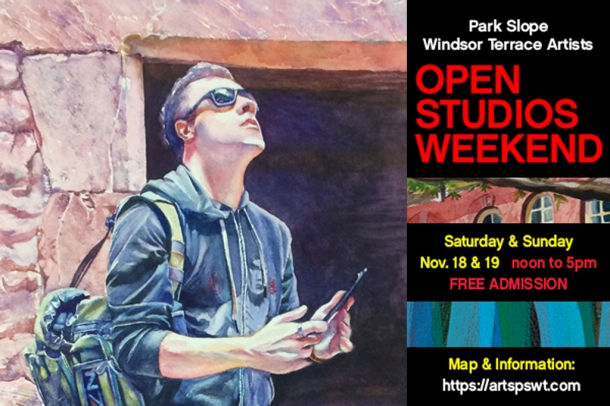
Over 30 artists in 20 locations. Shown, watercolor by Joy Makon, letter O on map.
A team blog created for and about artisanal small businesses

Over 30 artists in 20 locations. Shown, watercolor by Joy Makon, letter O on map.

Protestors advocating for voting rights to be extended to women were called “suffragettes,” rather than suffragists, to diminish them, much as the belittling term “women’s libbers” was used in the 1970s. Similarly, when Hillary Clinton was running, female supporters were accused of “voting with their vaginas.” In response, feminists now speak of their political “vagendas.”
THE FERVOR OF POLITICAL ENGAGEMENT since the 2016 election, notably — but not only — the global women’s marches on the day after President Trump’s inauguration, has startled commentators and politicians alike, and heartened some. But this should be no surprise, for protests are a solid part of the American experience. More than a hundred years ago, this American poet celebrated the fact that here “speech, thank God, no vested power…can gag or throttle.” Ella Wheeler Wilcox also complained of “the lawlessness of wealth-protecting laws.” Read on for more of her only-too-timely views.
By Ella Wheeler Wilcox
To sin by silence, when we should protest,
Makes cowards out of men. The human race
Has climbed on protest. Had no voice been raised
Against injustice, ignorance, and lust,
The inquisition yet would serve the law,
And guillotines decide our least disputes.
The few who dare, must speak and speak again
To right the wrongs of many. Speech, thank God,
No vested power in this great day and land
Can gag or throttle. Press and voice may cry
Loud disapproval of existing ills;
May criticise oppression and condemn
The lawlessness of wealth-protecting laws
That let the children and childbearers toil
To purchase ease for idle millionaires.
Therefore I do protest against the boast
Of independence in this mighty land.
Call no chain strong, which holds one rusted link.
Call no land free, that holds one fettered slave.
Until the manacled slim wrists of babes
Are loosed to toss in childish sport and glee,
Until the mother bears no burden, save
The precious one beneath her heart, until
God’s soil is rescued from the clutch of greed
And given back to labor, let no man
Call this the land of freedom.
Ella Wheeler Wilcox was born on November 5, 1850, at Johnstown Center, Wisconsin. She was widely read in her time, and Brooklyn Artisan recently reprinted a New Year’s poem of hers. Her books include Poems of Passion (1883) and Poems of Peace (1906). This poem was published in a collection in 1914, and may have appeared earlier in a periodical. Ms. Wilcox died on October 30, 1919, the year before the 19th Amendment was ratified, giving women’s voting rights protection under the Constitution.
 Brooklyn Artisan slipped out of the borough last weekend to attend the massive NY Now wholesale market held at Javits. Our mission: to locate designs and artisans that exemplified the best in handmade creativity. Result: a selection of beautiful products with a Brooklyn origin.
Brooklyn Artisan slipped out of the borough last weekend to attend the massive NY Now wholesale market held at Javits. Our mission: to locate designs and artisans that exemplified the best in handmade creativity. Result: a selection of beautiful products with a Brooklyn origin.
Above, a Brooklyn-themed card hand-printed by letterpress in the Bushwick studio of Lovewild Design. Lovewild characterizes itself as “family-owned, women-run” and has developed a range of handmade products that are highly sustainable. The greeting cards encourage reuse—seeds are embedded in the paper and will actually germinate into tiny wildflower patches when planted in soil. The cards provide charming and sometimes pointed sentiments—a favorite is “I’m so relieved you found someone to marry you. Really.” Lovewild founder Sierra Zamarripa insists that was what her grandmother actually said to her. It could qualify as Most New York Congratulations ever.
 Wilcoxson Brooklyn Ceramics displayed a wide range of bold, modern tableware in elegant forms and colors created in its Greenpoint studio. The style of ceramic is characterized by designer Kevin Wilcoxson as “New Modern,” a derivation of a traditional Japanese Mingei style and highly valued in museum gift shops. Another interesting activity of the studio is the schedule of workshops where participants get hands-on experience in the craft. Other craftspersons might want to consider how to incorporate similar real-world interactions into their businesses.
Wilcoxson Brooklyn Ceramics displayed a wide range of bold, modern tableware in elegant forms and colors created in its Greenpoint studio. The style of ceramic is characterized by designer Kevin Wilcoxson as “New Modern,” a derivation of a traditional Japanese Mingei style and highly valued in museum gift shops. Another interesting activity of the studio is the schedule of workshops where participants get hands-on experience in the craft. Other craftspersons might want to consider how to incorporate similar real-world interactions into their businesses.
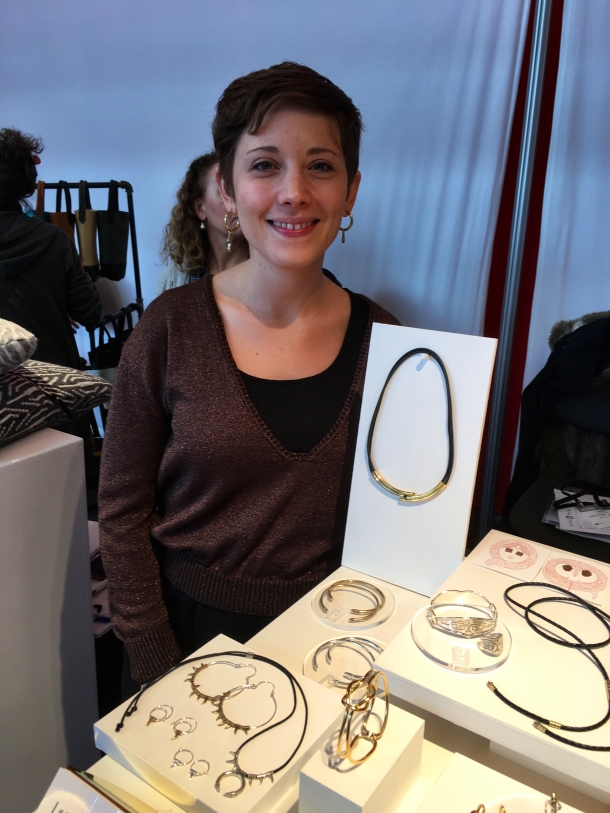 Jewelry definitely appears to be a growth industry in Brooklyn (viz. our piece from October). Swooping curls of sterling silver and gold are the creative product of designer Lucia Perluck, shown above in the Emerging Makers area at NY Now. Her minimalist designs under the label Lucia Pearl are available IRL in Crown Heights at Marché Rue Dix and online at Etsy. Especially notable is her collaboration with a Moroccan master engraver: Maalem and Maalema.
Jewelry definitely appears to be a growth industry in Brooklyn (viz. our piece from October). Swooping curls of sterling silver and gold are the creative product of designer Lucia Perluck, shown above in the Emerging Makers area at NY Now. Her minimalist designs under the label Lucia Pearl are available IRL in Crown Heights at Marché Rue Dix and online at Etsy. Especially notable is her collaboration with a Moroccan master engraver: Maalem and Maalema.

Williamsburg-based designer Tracey Tanner showed an impressive array of leather products—wallets, clutches, pouches—in an astonishing variety of leather finishes. (And here I was thinking leather essentially came in brown and black. Anyone for sparkling magenta?)
As a footnote, all the designers featured in this piece in all their diversity work within a one mile radius in the Williamsburg/Greenpoint/Bushwick nexus. It is becoming difficult to grasp the volume of creative energy across the whole of Brooklyn.

Windsor Terrace artist Susan Greenstein’s watercolor view from New York’s High Line (not for sale).
THIS WEEKEND (NOVEMBER 12-13) THIRTY-FIVE ARTISTS in Windsor Terrace and Park Slope will open their homes and studios and invite us in on Saturday and Sunday to have a look, talk about art or not, and maybe buy something, maybe not. The hours are 12 to 5 pm both days. Brooklyn Artisan is quick to attest on the basis of previous years that it’s a lot of fun to do and certainly should give you a good rest from politics.
To make a plan over brunch, check the map at parkslopewindsorterraceartists.com. (The map is downloadable. Most of the studios offer map printouts that you can pick up and carry with you.)
The site also has a Directory of Artists that’s set up to be fun to browse. Use it as a planning tool to choose studios most likely to interest you. In past years, Brooklyn Artisan has started our meanderings at the southeastern edge, 41 Fuller Place, with the dazzling watercolors of Joy Makon. Many of her subjects are local scenes, beautifully composed (and hard to resist. Ask Joy about giclée prints, too). One year we worked north and west to Park Slope, ending up with interesting conversation on technique in Simon Dinnerstein‘s impressive top-floor home studio (his Fulbright Triptych is world famous), and another year, we circled around Windsor Terrace, buying a charming Christmas book with illustrations by Dara Oshin and a watercolor by Susan Greenstein for Christmas gifts.
Warning: It may be hard to part with your gift purchases! (Susan’s watercolor view from the High Line hangs handsomely in this writer’s home even as she types. See homey photo above.)
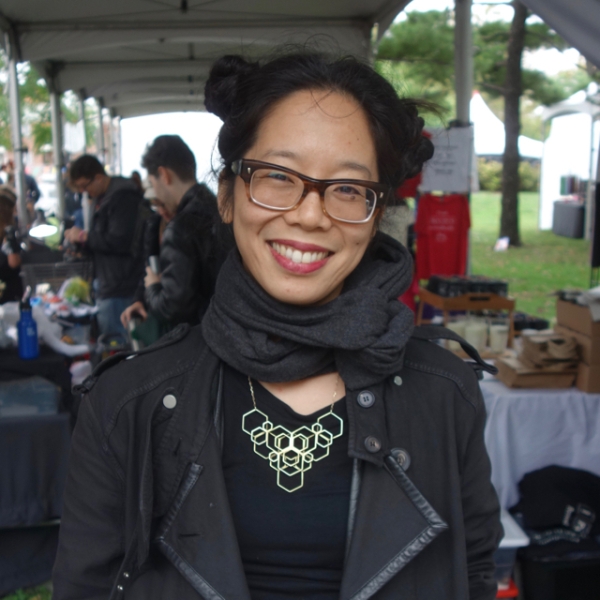
Emiko Shinozaki showing her elegant, chemistry-inspired jewelry at this year’s World Maker Faire 2016 (October 1 and 2 at the New York Hall of Science grounds in Flushing). Shinozaki, seen here wearing one of her signature pieces, lives in Carroll Gardens and works in her Dumbo studio (yes, artists still work in Dumbo). Trained in classical music, she chose jewelry design over medical school, yet keeps a link to her roots by often incorporating imagery that references organic chemistry, “especially caffeine.”
As if this election season weren’t scary enough, arts group Creative Time and artist Pedro Reyes are proposing to turn the Brooklyn Army Terminal into a political haunted house. Reyes wants to fill that amazing space with the “horrors of our political landscape.”
Creative Time is the .org that two years ago commandeered the defunct Domino Sugar plant in Williamsburg for Kara Walker’s A Subtlety, the spectacularly successful art installation that drew “yuge” crowds. At press time, the haunted house project was tantalizingly close to its funding goal. Donating now will ensure an October surprise. (Or like us, you can just stay curled up in a fetal position under the blankets until election day.)
This weekend! Nancy Doniger’s work and technique is interesting to learn about and her children’s book work is fun to see. Join Nancy, along with 21 other local artists for some surprisingly wonderful, affordable artwork to see and purchase.
![]() Park Slope Windsor Terrace Artists
Park Slope Windsor Terrace Artists
 Nancy Doniger ‘The Chase’ monotype with Akua inks on Masa Paper
Nancy Doniger ‘The Chase’ monotype with Akua inks on Masa Paper
Park Slope Windsor Terrace Artists, in conjunction with Art Slope, is pleased to present local artist Nancy Doniger, who will discuss her work as a children’s book illustrator and fine artist. Doniger will talk about ways that her fine-art process is both different from and similar to illustration art, what she enjoys about doing both, and her current focus on ‘hand pulled’ printmaking. On display will be samples of Doniger’s art work, including her published books.
Nancy Doniger is a Brooklyn artist/illustrator with works published in print and online for the New York Times, children’s books, businesses and nonprofits. Her fine art has been exhibited in NY, NJ, and MA. She has taught at…
View original post 58 more words

Konditori Swedish Espresso Bar in Prospect Heights
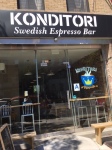 For Swedish espresso aficionados, or the merely curious, Konditori in Prospect Heights is on Washington Avenue between St. Marks and Prospect, where it projects a friendly attitude. “Keep calm and stay Swedish” is the message of the day. Cardomom Brod is a featured menu item. Or you could choose the hairy calorie bomb, aka the CocoBall. Other Konditori locations are in Park Slope, Cobble Hill, Williamsburg and Greenpoint (plus one on the Lower East Side in Outer Brooklyn). (Photos: Brooklyn Artisan)
For Swedish espresso aficionados, or the merely curious, Konditori in Prospect Heights is on Washington Avenue between St. Marks and Prospect, where it projects a friendly attitude. “Keep calm and stay Swedish” is the message of the day. Cardomom Brod is a featured menu item. Or you could choose the hairy calorie bomb, aka the CocoBall. Other Konditori locations are in Park Slope, Cobble Hill, Williamsburg and Greenpoint (plus one on the Lower East Side in Outer Brooklyn). (Photos: Brooklyn Artisan)
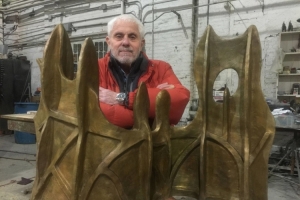
440 Gallery artist Richard Barnet at his foundry.
This Sunday, February 29 at 4:40 p.m., the six members of artist-run 440 Gallery in Park Slope will speak about their work in a Q&A session. Gallery curator and fellow-artist Karen Gibbons will moderate this panel discussion about the current exhibition: New Members Show 2016.
Celebrating a 10-year anniversary this year, 440 Gallery is a neighborhood and family-centered storefront where one can explore art on all levels. One or two member artists are always on site during open hours (Thursday through Sunday) to talk about current exhibitions and upcoming events.
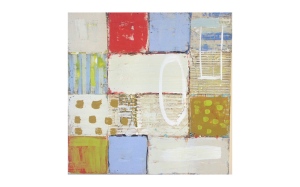
Painter Amy Weil works with encaustic media.
Upcoming events
(free, start at 4:40pm)
• Sunday Feb. 29: New Members Show Artist Talk
• Sunday March 6: Me, Myself and Eye: Andrew Drury Percussion—part of a monthly series of musical afternoons
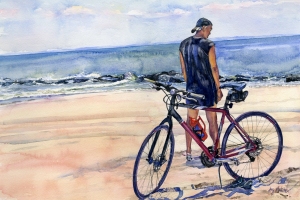
Joy Makon will speak about her watercolor process.
Updated events as well as current and upcoming exhibitions are listed on the gallery’s website.
Location
440 Gallery is at 440 Sixth Avenue (9th Street and 6th Avenue) in Park Slope, Brooklyn. F, G, R trains.
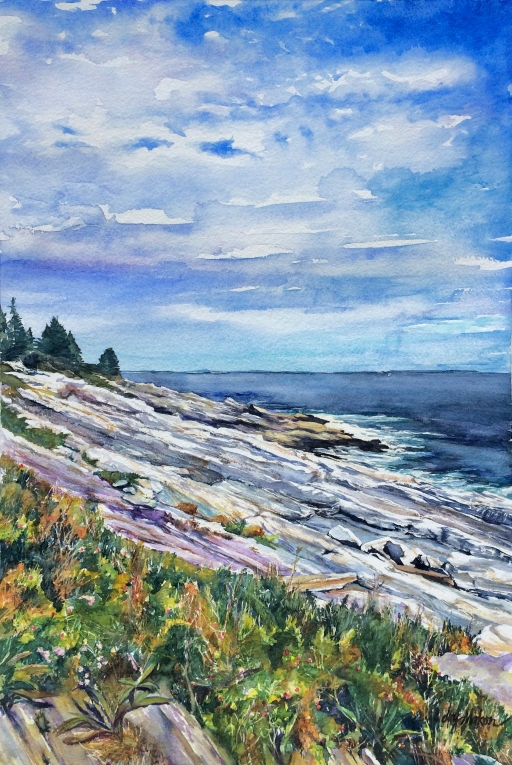
Facing East at Pemaquid Point, watercolor by Brooklyn Artisan executive editor Joy Makon. At letter R on the weekend open studio tour.
Weather reports forecast a beautiful late-fall weekend, November 7 & 8—a perfect time to wander about Park Slope and Windsor Terrace and pop in and out of the 34 artist studios that will be open for viewing this weekend.
The third annual Park Slope Windsor Terrace Artists Open Studio Tour features a mix of cutting-edge, classic and experimental work from established and emerging artists who make Brownstone Brooklyn their home. Many of the artists on the tour recently participated in Gowanus Open Studios and if you had a chance to discover art there, you’ll be pleased to find a lot more this weekend.
Information: Tour website, downloadable map & suggested itinerary, Facebook
Look for the green balloons outside of each open studio location. FREE.
Some highlights from the 34 artists on this year’s tour:
NORTH SLOPE studios: painters Gregory Frux and Janet Morgan, letter I on the map; distinguished classical artist Simon Dinnerstein, letter F on the map, mixed-media painter Jerry Friedman, letter H on the map.
SOUTH SLOPE studios: metal-sculptor Janet Goldner, letter Y, will be doing welding demos over the weekend; David Weiner, also at letter Y, will create event-based sculpture in real time; abstract painter Joy Walker, letter X; printmaker, illustrator, painter Nancy Doniger and kinetic metal sculptor Eric Jacobson, showing at letter G; digital/photo/social commentary artist Bob Hagan, letter M; plus 9 additional open studios—check the map.
WINDSOR TERRACE studios: sculptor Lisa Lincoln, letter P, will be creating with clay on Sunday; functional potter Caryn Kreitzer, letter O; at letter E: monoprints, watercolors by Susan Greenstein plus watercolors, photography by Phil DeSantis, plus 4 additional open studios—check the map.
Plenty of great places to stop and refuel along the route…but you knew that already…
THIS COMING SATURDAY, MAY 9, BROOKLYN ARTISTS will begin showing their work in a juried show at Brooklyn Waterfront Artists Coalition’s Red Hook waterfront location near the Fairway grocery store. The reception Saturday is 1-6pm, and the show continues until June 14. (www.facebook.com/BWAC.ART or bwac.org) Brooklyn Artisan proudly notes that executive Editor Joy Makon (https://joymakon.wordpress.com/) will be there, for she has a watercolor in the show. (Image above is a detail from an earlier painting.)
SO SAYS INFORMATIONWEEK. In the 2015 InformationWeek “Elite 100” listings of top business-technology innovators, the Brooklyn Public Library not only makes the list – the only library to do so – but it’s no. 25, rubbing shoulders in the top quarter with UPS and FedEx, NASA, Boeing, Biogen, PayPal, TIAA-CREF and Merck. Why? “As a result of our partnership with Tableau,” says the library’s President and CEO Linda Johnson, “BPL’s 60 branches are more responsive than ever to the needs of the communities they serve.” The library’s eResources – meaning eBooks and eVideos, catalog info, even homework help – serve Brooklyn’s 2.5 million residents 24/7 at www.bklynlibrary.org. See ya’ at the libe — online.
READ INVESTOPEDIA’S SPECIAL REPORT on starting a business in New York City, filled with stories of Brooklyn business startups. You’ll see why Brooklyn and Queens are magnets for innovation and small-batch production as well as get important leads to New York City services that can untangle regulations and smooth your way. (Full disclosure: The Investopedia story is brought to you by founding folks at Brooklyn Artisan.)
BROOKLYN-RESIDENT PATRICK PHILLIPS, who teaches at Drew University, is also a working poet with several titles published. The most recent, Elegy for a Broken Machine, is just out from Knopf and in bookstores now ($20) or in a Kindle edition from Amazon ($12). He is reading tonight (April 2, 2015) at Drew University (with Tiphanie Yanick) and later this month at a Poetry Society gig in the Fulton Street Subway Station. Keep up with his readings schedule at www.patrickthemighty.com. (The following poem is reprinted with the poet’s permission.)
The Chinese truck driver
throws the rope
like a lasso, with a practiced flick,
over the load:
where it hovers an instant,
then arcs like a willow
into the waiting,
gloved hand
of his brother.
What does it matter
that, sitting in traffic,
I glanced out the window
and found them that way?
So lean and sleek-muscled
in their sweat-stiffened t-shirts:
offloading the pallets
just so they can load up
again in the morning,
and so on,
and so forth
forever like that—
like Sisyphus
I might tell them
if I spoke Mandarin,
or had a Marlboro to offer,
or thought for a minute
they’d believe it
when I say that I know
how it feels
to break your own
back for a living.
Then again,
what’s the difference?
When every light
for a mile turns
green all at once,
no matter how much
I might like
to keep watching
the older one squint
and blow smoke
through his nose?
Something like sadness,
like joy, like a sudden
love for my life,
and for the body
in which I have lived it,
overtaking me all at once,
as a bus driver honks
and the setting
sun glints, so bright
off a windshield
I wince and look back
and it’s gone.
MORE THAN A NOVELTY, three-dimensional printing pioneered here in Brooklyn by MakerBot and some other companies around the globe is making its mark on the world. Here’s a seasonally heart-warming tale that tells why.
IN THE SINGULAR ECOSYSTEM that is Kickstarter, one will encounter many evolutionary dead ends—projects, visions and dreams that wither away unfunded. Then there are the mysterious campaigns that don’t just meet their targets, they blow by them and reach double, triple or stratospherically higher funding results. Why and how do these hyperachievers succeed, and can we learn any lessons by studying their success?
Here’s one that caught our eye at Brooklyn Artisan. Scott Teplin was creating his massive, quirky and highly detailed drawing called Big Canal and asked Kickstarter support for a hefty $4,500 to complete it. On the face of it, Scott is like many an artist—with a pen, a brush and a dream. But by the end of the campaign, his project was overfunded 11 times, garnering more than $49,000, which is a goodly chunk of the annual salary for a Brooklyn artist.
Big Canal is one of those drawings with lots of quirky details that demand hours to explore—Where’s Waldo? without the people, Richard Scarry without the cute animals. What is the secret of its funding phenomenon? The campaign video stars Scott and, though mildly amusing, won’t win a Palme d’or. Maybe it’s the many photos on his Kickstarter page that engage the viewer in the overall process. Or it could be his suggestive marketing that positions the reward as a great poster for a kid’s room. Or maybe it just appealed to the random whim or previously undetected want of the Kickstarter audience.
One thing is certain: The man can sure draw donuts.

Lace: an elegant example of Andrej Ulem’s architectural candles
ANDREJ UREM IS BUILDING CANDLES THAT ARE DEFINITELY IN A NEW MOLD. Straying far from the traditional cylinder shape, they explore form and texture in intriguing directions—creating what the artist terms “livable art pieces.” His Kickstarter campaign seeks funds for a 3-D printer that will enable him to create more precise and complex molds for future designs. Backers are rewarded with their choice from his current line of candles.
THE OLD STONE HOUSE near the edge of J.J. Byrne playground in Park Slope is once again the historic venue for independent Brooklyn bookstores and booksellers to offer their choices to holiday shoppers, including second-hand volumes sadly out of print. The New Yorker calls them “literary gems.” Look for booksellers Honey & Wax, Freebird Books, Faenwyl Bindery, and more than a half dozen others. Speaking of the New Yorker, at 2pm artist Maira Kalman will sign copies of her latest, My Favorite Things. The Brooklyn Holiday Book Fair‘s hours are from 11am to 5pm. (See Brooklyn Artisan’s past coverage of this event)
Washington Park, Third Street (@Fifth Avenue), Park Slope. theoldstonehouse.org
WINDSOR TERRACE WAS OUR STARTING POINT yesterday, the first weekend day of the Open Studios event. (From Manhattan, take the F train to 15th Street and follow the map from the OS website.) Walk down Fuller Place, one of the most nearly perfect blocks in the area, with its contiguous front porches, to #41 where you’ll meet watercolor artist Joy Makon, who speaks interestingly and unpretentiously about her work and technique. After a long and successful career as a magazine, online and book cover designer, and columnist for Brooklyn Artisan, last year Makon began to bloom as a painter as well. Some of her pieces are for sale (several were snapped up yesterday), and for a few, excellent giclée print reproductions can be bought at very reasonable prices.
From there, using our map, Brooklyn Artisan made our way down Windsor Place to 229A, to see the city-themed watercolors of Susan Greenstein, an artist with 440 Gallery, and the rural landscapes of Phil DeSantis. Once again, the friendly and accessible artists were on hand to talk with you. (Many pieces were available with prices in the hundreds and some very good print reproductions were priced as modestly as $20.)
Simon Dinnerstein‘s house at 415 First Street (follow your map and stretch your legs a bit) serves as home, gallery and studio. You can hang your coat on the garden floor and wind your way through that floor, up to the parlor and then on to the top-floor studio, seeing his paintings and black and white graphite brush pieces all along the way. Dinnerstein is internationally known, especially for his The Fulbright Triptych, and locally beloved as a teacher as well as fine artist. Once again, the conversation was a wonderful supplement to the art. (His daughter, Simone Dinnerstein, is also known as a concert pianist.)
ALTOGETHER A SPECIAL AFTERNOON of visual adventures, good art talk, and a house tour as well! You can retrace our steps today or make your own itinerary from among the many more studios open today.

How Brooklyn resident Winslow Browning, above, managed to teach this writer a thing or two about classical Spanish guitar. (Photo by Goodman/Van Riper Photography)
GROWING UP IN A SMALL KANSAS TOWN, I wanted to learn to play an instrument because all the smart kids knew how to play an instrument. My parents ignored me, but they let me get a car instead. I really didn’t do anything about the whole music thing until one Saturday morning here in the big city when I walked into a music store in midtown Manhattan and bought the cheapest guitar possible (“You can pay more,” a college friend said, “but you can’t pay less”) and toted it back to my apartment. Then I sat on my couch and stared at it for a while and realized I might’ve made a mistake since I didn’t have a clue how to play it, but I refused to accept that idea.
That’s when I found Park-Slope-based Winslow Browning on the internet. We talked and he asked me what style I wanted to learn—Rock? Classical? Country? Um, Easy Listening?
Gee, I hadn’t thought about that. “I like the Beatles?” I said, except it did sound more like a question.
“Okay,” he said.
“Yeah. I have a T-shirt with their drum logo on it and everything.”
“Okay,” he said.
TWO DAYS LATER HE SHOWED UP AT MY APARTMENT at the appointed hour with his guitar, which looked to me like the most beautiful instrument this side of Spain. He examined my guitar critically, then he showed me how to sit properly, how to hold it, and how to play the notes of a scale — you know, Every Good Boy Does Fine. He showed me flats and sharps. Then he told me to pick up a music stand and First Lessons for Guitar (Las Primeras Lecciones de Guitarra) by Julio Sagreras.
We never spoke of Rock, Country, Easy Listening or The Beatles again, but he did do his best to teach me how to play Spanish classical guitar.
AND 15 YEARS LATER BROWNING IS STILL AT IT, as he has been all his life. “When I was growing up, my parents had a string guitar lying around my house,” he says, “and I learned chords and stuff playing with my friends, then I had a chance to take classical guitar lessons and it made my heart flutter.”
Browning went on to study music with renowned classical guitarists Fred Nance and Juan Mercadal, the latter a Cuban master. “I was so totally steeped in the classic music field and so hungry to reel that all in and take all these classical classes, all this pop music stuff got tossed out on the other side,” he told me.
SO THAT’S WHAT HAPPENED TO MY LEARNING TO PLAY “DAY TRIPPER” AND “I FEEL FINE.” I wouldn’t say I was an abject, miserable failure at classical guitar (although the pieces Winslow did manage to teach me sounded nothing like they did when he played them) because he taught me how to play scales and tune it and change strings when I had to. And I can still do all that stuff when forced to at knifepoint. He also taught me that it was a good thing my parents didn’t waste money on music lessons for me and let me waste it on a car instead. But in his hands even my cheapo axe sounded beautiful.
IT’S A GREAT THING THAT WINSLOW’S STILL AT IT, sometimes giving lessons in his five-floor walkup, or anywhere around the city really — he comes to you. Also, he and his wife, accomplished flautist Suzanne Gilchrest, present a limited concert series with their group Guitar Among Others. Like Paul McCartney’s later career, or Steely Dan’s, GAO’s lineup always changes. And each summer they travel to Summerkeys, a summer camp for classical musicians in Lubec, Maine, where he’s the only guitarist who teaches solo playing.
“In the Brooklyn Eagle a few years ago there was an article that talked about how Brooklyn was made up of a bunch of small towns and villages,” he says. “I love telling the story in Lubec because it really is a small town; it’s very comfortable, and you’ll walk up the street and someone will say ‘Hey, that was a great concert last night.’” No wonder they say that to him: Like I said, the guy really knows how to play a mean Spanish classical guitar.
Today, Executive Editor Phil Scott plays a mean keyboard — of the qwerty sort — and as you can read for yourself here he also knows how to twirl a dial.
 As Ample Hills Creamery oft reminds us, Walt Whitman wrote admiringly about our Kings County homeland. The words below, however, are Whitman speaking of the country as a whole and what makes “America’s choosing day” so quintessentially American: “the swordless conflict” to be resolved at the ballot box.
As Ample Hills Creamery oft reminds us, Walt Whitman wrote admiringly about our Kings County homeland. The words below, however, are Whitman speaking of the country as a whole and what makes “America’s choosing day” so quintessentially American: “the swordless conflict” to be resolved at the ballot box.
If I should need to name, O Western World, your powerfulest scene and show,
‘Twould not be you, Niagara—nor you, ye limitless prairies—nor your huge rifts of canyons, Colorado,
Nor you, Yosemite—nor Yellowstone, with all its spasmic geyser-loops ascending to the skies, appearing and disappearing,
Nor Oregon’s white cones—nor Huron’s belt of mighty lakes—nor Mississippi’s stream:
—This seething hemisphere’s humanity, as now, I’d name—the still small voice vibrating—America’s choosing day,
(The heart of it not in the chosen—the act itself the main, the quadriennial choosing,)
The stretch of North and South arous’d—sea-board and inland—Texas to Maine—the Prairie States—Vermont, Virginia, California,
The final ballot-shower from East to West—the paradox and conflict,
The countless snow-flakes falling—(a swordless conflict,
Yet more than all Rome’s wars of old, or modern Napoleon’s) the peaceful choice of all,
Or good or ill humanity—welcoming the darker odds, the dross:
—Foams and ferments the wine? it serves to purify—while the heart pants, life glows:
These stormy gusts and winds waft precious ships,
Swell’d Washington’s, Jefferson’s, Lincoln’s sails.
A small footnote: 1884 is the year that Coney Island started building its roller coasters, a perhaps-too-perfect political symbol.
 Getting ready to hang a lot of paintings for next weekend’s Park Slope Windsor Terrace Artists Open Studio Tour. Hope you can stop by!
Getting ready to hang a lot of paintings for next weekend’s Park Slope Windsor Terrace Artists Open Studio Tour. Hope you can stop by!
Saturday November 8 and Sunday November 9 from noon to 7pm each day.
Full information, including a map listing the two dozen participating artists, is on the group’s website.

Watercolorist and Brooklyn Artisan executive editor Joy Makon will be participating in the Open Studio weekend.
Park Slope Windsor Terrace 2014 Artists’ Open Studio Tour
Saturday, November 8 & Sunday, November 9, noon to 7pm each day.
The artists and photographers of the Park Slope Windsor Terrace Artists Group invite everyone to visit their studios on November 8 and 9.
This unique urban experience will be a chance to visit over two dozen studios located in Brooklyn Artisan’s neighborhoods of Park Slope and Windsor Terrace. Studios are within easy walking distance of each other (see the tour map) and accessible by several subway lines. There is no fee for the tour.
This is an excellent opportunity to visit active Brooklyn artists and view new, local art. Expect to see a wide selection of art—painting, photography, ceramics. By going to the artist’s studio and meeting the creator, you will discover the history and story behind each piece.
Samples of the artists’ works, printable maps of the studio tour, contact information for each artist and details of this event may be found at the Open Studio Tour website.
For more information, please contact: tomkeough@tomkeoughartist.com or 718-768-6171
MY 1979 KZ 750 WASN’T MUCH TO LOOK AT BUT it was clean with no major dents or scratches and nice chrome fenders and a seat in fine shape. Some days I’d ridden longer than 12 hours at a stretch. The bike always made it better than me. Besides burning oil it was mechanically sound. Except the irreplaceable mechanical ignition points—which lasted a decade. The bike’s book value was $70. One final time I file the points and barely made it to the nearest shop that would deign to take it.
That was 13 years ago. I still have the manual.
Now Chris Rinken tells me $30 would put it back on the highway.
“[Expletive deleted],” I say.
“I’m sorry,” he replies.
Rinken, owner of Wrench N’ Ride Motorcycle Repair, a small garage beside his home on the corner of Seigel and Bogart streets, works exclusively on pre-electronic, vintage motorcycles—anything ’81 and older. He tells stories that start out like mine.
“One guy kinda had no idea what to do to get his ‘72 CV 350 running. It was in storage for six years and he paid $600 for it and owned it for two years but it never ran. He was pushing it around from apartment to apartment, and—a total fluke—luckily for him there happened to be motorcycle shop,” Rinken says. “He was super pumped about it.”
Rinken didn’t replace a part, he just cleaned the carb. “The bike just needed some care,” he shrugs. And that’s all he does. Rinken stays away from body work or welding, but he can recommend someone.
“If it runs I completely leave it at that,” he says. Rinken first started riding at 11 and learned to work on bikes from his dad. Basic, simple stuff. “Nobody knew how to do vintage maintenance,” he says. “They weren’t raised with a dad who knew all that stuff.”
After graduating from law school in ’12, into the worst economy this side of the Depression, he opened Wrench ‘N Ride. Today he has eight vintage bikes in the garage. One ‘64 Honda 90 cc that he laid hands on is worth $2,500 dollars now.
A shop like Wrench N’ Ride is rare, unique even, considering the sheer number of motorcycles in Brooklyn. To help people buying vintage bikes make sure they weren’t being scammed, Rinken offered a second set of eyes. “A couple of customers wanted to learn basic maintenance, basic inspection stuff,” he says, “just as a way to make sure to get it on the road and avoid really expensive bills from the repair shop.” He’s starting classes now. “We have motorcycles in the shop, and we have extra tools. We get people here who want to learn about bikes, who maybe want to get into it, try it to see if they like doing it. It’s all about getting people into the community.
“I’d rather have a bike that’s worthy,” he says. “The last bike the shop sold was an old Honda 360 that had flames on it. It does a hundred miles an hour if it needs to.”
Wrench N’ Ride Motorcycle Repair
315 Seigel Street
Bushwick, Brooklyn NY 11206
608 695-8392
Phil Scott is an executive editor of Brooklyn Artisan, a former managing editor of Omni magazine, and the author of seven books, mostly about the history of aviation. He lives in Rockaway.
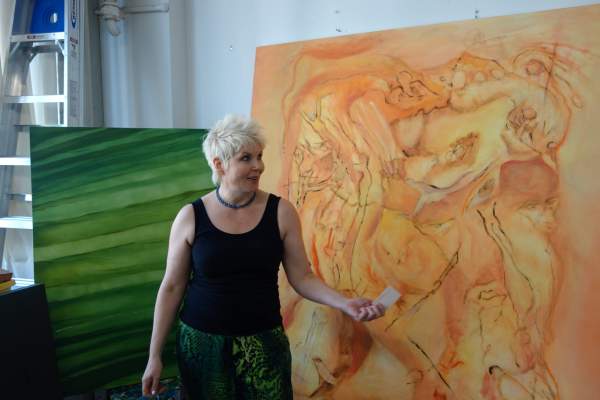
Judith Mills talks about her Stuckist paintings in her Brooklyn studio. (Brooklyn Artisan Photo Pool)
“I’VE ALIGNED MYSELF WITH STUCKISM FOR TWO YEARS,” says Judith Mills, on Open Studio day at Industry City late last month. “It has really helped me,” she says, with emphasis. With your art?, Brooklyn Artisan asks. “Yes. It enabled me to narrow down my focus to the realistic—what’s real, you know—and then to pull out to the expressive.” She gestures energetically toward the wide range of large canvases around her, wonderful, colorful, magnetic, different from one another — all that and more —and to Brooklyn Artisan, not remotely realistic.
“But the biggest surprise?” Judith continues. “It unstuck me in other areas of my life as well.” “You mean with money?” a studio visitor asks. Judith is nodding. “Or with friends?” More nodding. Judith adds, “I’ve been much more — well, here,” she says, pointing to a wire in-basket with printed pages. “You can read it.”
It is titled “THE STUCKISTS,” referring to a quote from Tracey Emin: “Your paintings are stuck, you are stuck! Stuck! Stuck! Stuck!” The subtitle of the manifesto is “Against conceptualism, hedonism and the cult of the ego-artist.” The manifesto dates from April 8, 1999, and is signed by Billy Childish and Charles Thomson. (“First published by The Hangman Bureau of Enquiry,” it says at the bottom, and gives an English address, in Kent.) It advocates authenticity in one’s work, one’s art, one’s life and one’s self.
Judith Mills is one of the artist-organizers of Open Studios at Industry City, the complex of lofts and warehouses at Bush Terminal, in Sunset Park, Brooklyn. About 75 studios belonging to artists, photographers, stained-glass craftsmen, jewelers, musicians, and textile designers,were open to visitors.
And The Stuckists? Per Wikipedia: “Tracey Emin, CBE, RA (born 3 July 1963) is an English artist. She is part of the group known as Britartists or YBAs (Young British Artists),” and then it details a number of Bad Girl behaviors (such as being “drunk and swearing” on live TV), but not as many, apparently, as Tracey herself has revealed. For instance, in 1997 Emin showed Everyone I Have Ever Slept With 1963–1995, a tent appliquéd with quite a list of names, at the Royal Academy in London. More lately she was appointed of the Order of the British Empire, and is one of only two female professors—ever—at the Royal Academy since it was founded in 1768. Functioning in such a culture might make anyone behave like a Bad Girl.
Ah, but Brooklyn Artisan doth digress. Open Studio day at Industry City on April 26 was a “first annual” — that is, a pioneering experiment — meant to foster community both within and outside the circle of creative tenants at the vast Bush Terminal industrial and warehousing facility in Sunset Park. Some studio hosts offered light things to eat and drink and were happy to speak about their work. [Update from Judith Mills: “The show went better than expected. I was selected to do a live painting performance that will be May 30th on the rooftop atrium of the Park Restaurant in Chelsea for a fundraiser. I am very excited for this opportunity that developed out of the open studios.”]
Megan Grissett, who lives in Sunset Park, saw a notice of the Open Studios event posted in a neighborhood cafe and was eager to come over. A graduate of Savannah College of Art and Design, Megan came to New York from Raleigh, North Carolina, about three years ago. “I live up the street,” she explains, and says she ‘d always wondered about Industry City.
“I work as a social media specialist at an ad agency in Manhattan,” she says, “and I don’t have much time for sketching, or a place for it.” But she had wondered if the atmosphere at Industry City would be too commercial. “Now I think it would be a great environment,” she says wistfully. “I would have to share space, though.”
As we sit and chat on one of wooden benches in a hallway on the fourth floor of Building B, Megan glances down at a fresh tattoo on the top of her right foot. Rendered in green and red, it is the image of a long-stemmed budding rose. “I just had it done,” she confides, “in memory of my grandmother, who died about a month ago. I’ll think of her every time I look at it.
“We were very close,” Megan says, in her soft accent. “I don’t want to ever forget her.”
See Brooklyn Artisan’s prior stories on Industry City Open Studios. More coverage of artists and their studios will be posted this week.
Anne Mollegen Smith also writes personal finance articles for investopedia.com.
SORRY, FOLKS, THE DISCOUNT WAS JUST FOR THE DAY, last Saturday, the first Open Studios at Industry City in Sunset Park, and you missed it. But you can feast your eyes anyway, as Brooklyn Artisan did, while talking about the Maria Castelli business that just launched last month.
“We just launched,” daughter Veronica explained, “but we’ve been working on it for about a year and a half.” Though her lovely face was free of bags under her eyes or furrows in her brow, her expressive body language managed to suggest some weeks of round-the-clock effort.
“It’s a lot of work,” she confided, as her mother talked to a handful of serious-looking people on the other side of the room. Retail buyers, we hoped, who’d put dozens of these handsome bags into distribution.
The bags are rich looking with thick pebbled leather, yet flexible and almost slouchy in construction so that they’re easy to wear on your shoulder. (Just don’t load up with the Yellow Pages or bags of river rocks and you’ll be fine.) Although some small pouches on another table had the ubiquitous industrial zipper as design statement du jour as well a closure, the handsome shoulder-able bags were clean and as zipperless as Erica Jong’s famous **** (Fear of Flying).
We also liked the alternate bag in black that we spotted on a side shelf. The leather tassel of the blue version was replaced by two bunches of feathers on the black. Irresistably touchy-feely—in fact, we were quite tickled by them.
A co-founder of the erstwhile Getting It Gazette, Anne Mollegen Smith also writes about personal finance for investopedia.com.
See our other Industry City Open Studio coverage, with more to come later this week.
“I CAN SEE THROUGH MY HANDS’ is what the young artist Dylan Vandenhoeck called the work he was showing Saturday in his @SO WHAT SPACE in Industry City Building B, where he has space B424 (that signifies his room on the 4th floor of Building B in the huge complex that formerly was the Bush Terminal in Sunset Park, Brooklyn).
Yesterday was Industry City’s first Open Studios day. Organized cooperatively between Industry City and some of its creative tenants, the event was an invitation to interested visitors to “get a rare glimpse of works in progress, and discover how each tenant has customized a raw studio space to fit his or her medium and personal style,” its brochure said.
“Gibsonia” is based on a real place remembered, Dylan explained to Brooklyn Artisan. It was done in oil on canvas. The contrast is exaggerated between the dark room and the soft rug with vibrating colors, and the brilliant scene beyond the window sill’s plants.
In “Palm at the End of the Mind/After Image,” right, a newer work in oil on linen, which appears to be two pieces joined into one, the contrast is as though you stared at the bright palm fronds on the left and then closed your eyes, seeing the after image on your retina and in your mind.
That concept sets a theme for the whole day’s happy experience of wandering from studio to studio, seeing work in progress and talking with the artists, photographers, designers and artisans practicing their craft. Over coming days, Brooklyn Artisan will report on more studios we visited.
Former editor-in-chief of Working Woman magazine and the Art of Simple Living, Anne Mollegen Smith also writes about personal finance for investopedia.com.
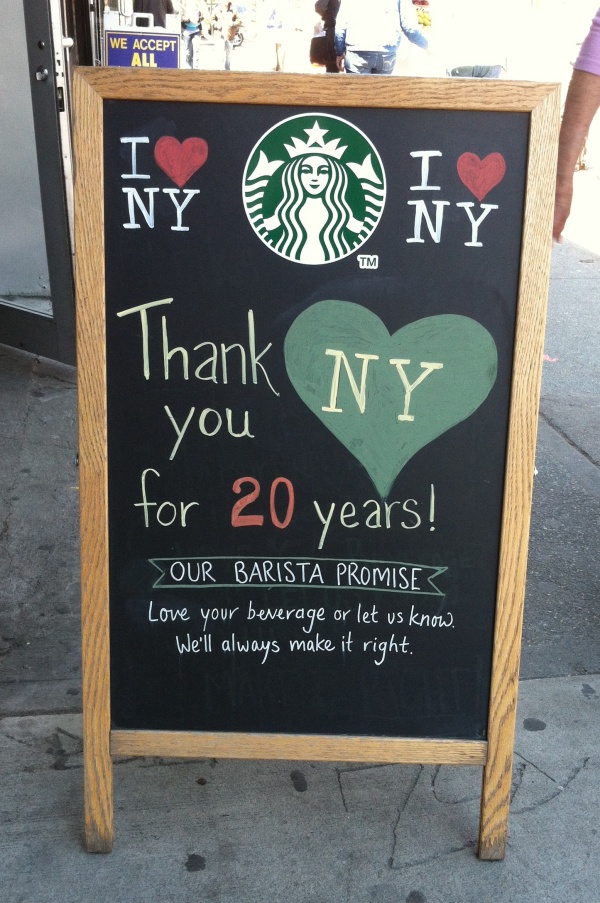 Outside the newish Starbucks at the intersection of Park Place, Seventh Avenue and Flatbush Avenue is this message. (Brooklyn Artisan photo pool)
Outside the newish Starbucks at the intersection of Park Place, Seventh Avenue and Flatbush Avenue is this message. (Brooklyn Artisan photo pool)

Co-authors Brian Smith and Jackie Cuscuna included Ample Hills’ famous salt crack caramel recipe in the new cookbook, which can be yours for $25.00. (Brooklyn Artisan Photo Pool)
YESTERDAY WAS PUBLICATION DAY for the new Ample Hills Creamery cookbook, and copies were stacked up on the counter at the popular premium ice cream store on the corner of Vanderbilt Avenue and Bergen Street, in Prospect Heights.
Proprietor Brian Smith, right, was on hand in a front booth to inscribe copies. He confirmed to Brooklyn Artisan that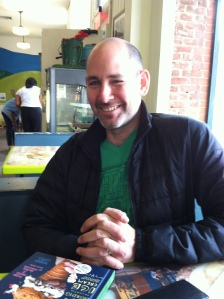 the company’s new location in Gowanus is scheduled to open by late June. Ice cream will be made right on site as at the Prospect Heights location.
the company’s new location in Gowanus is scheduled to open by late June. Ice cream will be made right on site as at the Prospect Heights location.
“Our business is more than an ice cream store, really,” Smith said. “It’s a neighborhood hangout.” The Prospect Heights store has a toddler play area, just visible over Smith’s shoulder.
The familiar Ample Hills ice cream carts will be back out in their locations near playgounds and parks this summer also. Smith co-founded the business with his wife and cookbook co-author, Jackie Cuscuna.

Just one of the many Brooklyn projects raising funds on Kickstarter:
Sogoal Zolghadri produces artful and sometimes irreverent cookies
at her Sogi’s Honey Bakeshop.
THE MOST RECENT CREDIT CRUNCH began in 2008 and reportedly ended this summer. Remember those images of Lehman Brothers staff tossed to the sidewalk with their little boxes of belongings? In the months following, credit dried up and small businesses were starved for the financing needed for growth and hiring, laying the basis for a long grueling recession. But also within those same months—in April 2009—a small startup launched in Manhattan that has become the go-to funder for creative projects: Kickstarter was born. In the four years since its founding, Kickstarter has gone viral and raised pledges of more than $870 million in crowd-sourced funds from more than 5 million backers. (Like any good Internet company, it posts its stats online.)
The premise of Kickstarter is that entrepreneurs, artists, designers, musicians or filmmakers with ideas bigger than their bank accounts can launch a campaign on the Kickstarter site, set funding goals (which can grow over time) and deadlines, provide incentives to investors for various funding levels, and generally plead their case to gain followers (think Facebook “likes” with dollar bills attached). The ideas flourish or languish, gaining financing or not in a mysterious financial Darwinism. Some projects blow past their target budgets by tens of thousands of dollars, while others fizzle out despite their merit.
Given the power of Kickstarter for small creative inventors, makers and producers, Brooklyn Artisan will be covering it as a financial and manufacturing beat, highlighting the notable, successful, hopeful, and even the occasional noble-yet-doomed project. As well, we will provide advice, tips, strategies and tactics to aid in successful campaigns.
Brooklyn is certainly well represented, with more than 2,000 projects currently raising funds, more than double the number of projects coming out of London, for example. To look for promising projects or to make sure your investments stay in borough, Kickstarter provides city-based discovery.

The Brooklyn Brief commuter bag by Owen & Fred of Greenpoint comes with a handy inspirational
quote screen-printed on the inside.
Today, we’re highlighting two projects. The first, by Greenpoint-based Owen & Fred, is a series of bags (above) that is tantalizingly near to reaching the $45,000 campaign goal. The bags are promised to be durable, sustainable, meticulously detailed and U.S. made. One nice touch is the inspirational quotes screen-printed on the inside, for your eyes only.
Sogi’s Honey Bakeshop (picture at top of post) set less ambitious goals: raise $6,500 to buy supplies and a bigger mixer to aid the creation of the hand-painted cookies that have already attracted the attention of Martha Stewart Weddings and are popular on Etsy. Happily, baker Sogoal Zolghadri has raised the money and then some.
It can be a lot of work and planning to produce a campaign that meets or surpasses its goal. Kickstarter itself provides some basic tools and information to get you started. But who knows—next time there is a big shakeup in the financial world, those staffers might be seen shlepping their belongings in one of your Brooklyn-produced duffel bags.
SMALL, MEDIUM, AND LARGE: Otherwise, it’s hard to categorize the ingenious designs of Brooklyn makers at The Factory Floor in Industry City in the recent two-weekend show. But starting small, Brooklyn Artisan will do our best, for the record.
Small batch, small scale, big thinking at bhold design: Product development under the eye of Susan Taing, founder, takes certain characteristics from the MakerBot desktop 3D printer used to produce prototypes in the bhold lab. Double-walled thermal saki cups, for instance, with little fingerholds on one side.
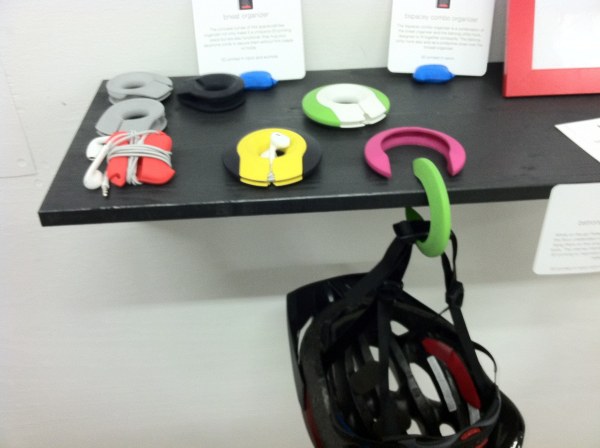
Using the MakerBot 3D desktop printer, bhold labs can turn around and refine prototypes in a few hours that might take days in traditional development cycles. (Photo: Brooklyn Artisan Photo Pool/dfs)
Or—our favorite, above—colorful little two-tone, two-piece objects that separate: the outer C-shape that hangs on the restaurant table and holds your bag or helmet by its handle or chin strap; and the inner part that emerges to wind and store your earbuds tangle free. You can work with the bhold labs on your own designs; contact susan@bholddesign.com. Or like us, you can just stand at a design show and play with the appealing objects fitting them together and taking them apart over and over again as minutes tick by.

Founder/owner Mark Righter crafted sliding shelves that don’t tip, thanks to the sliding dovetail joint. (Brooklyn Artisan Photo Pool/ams)
Small detail, big advantage: Cambium Studio is a Brooklyn-based woodworking furniture and design company founded by Mark Righter. From its Greenpoint location, Cambium will create custom designs for clients, and on its website offers a portfolio of pieces of its own design.

Talking shop with a potential client, Cambium Studio’s founder Mark Righter, with coffee, is next to his shelves with sliding dovetails. (Brooklyn Artisan Photo Pool/ams)
What caught our eye at The Factory Floor was deceptively simple but elegant shelving for display of favorite small objects—a place to put the candles, the Japanese vase, the framed photo—that can be adjusted as the array of objects changes. How?
The framework is hung from a secure cleat on the wall, but individual shelves operate on a sliding dovetail joint. The shelves, using bamboo, are beautiful finished and the sliding function gives you an excellent excuse to pat them and fiddle with them for the pleasure of touch.
Then there’s the MidCentury-looking coffee table with lift up hinged covers on its four storage compartments. Three of the covers are in a 60s’s orange and one is in bamboo strip laminate. Fittingly it is named Mod Quad by Wonk, its maker.
Other combinations of finishes to suit individual clients are possible, Wonk’s website says. In fact, since each piece is custom-made for you, you are confronted with swatches and urged to pick from them. Takeaway notion? Wonk if you love finishes.
Along with others, Pratt Institute was a co-sponsor of the design show at The Factory Floor. At the Pratt Industrial Design booth—Pratt Institute is, by the way, based in Brooklyn—Brooklyn Artisan was engaged by a very clean-lined yet comfortable loveseat. The foam cushions made it quite sittable. And as its Pratt graduate designer demonstrated, the cushions can be flipped to your choice of color contrasts.
More coverage from the recent Brooklyn design show at The Factory Floor in Industry City, Sunset Park, is to come in the next few days. For Brooklyn Artisan’s prior coverage, follow these links:
AT THE BROOKLYN DESIGN SHOW LAST WEEKEND this beautiful bed was practically a show-stopper for Brooklyn Artisan: We wanted to kick off our boots and lie right down in the calm surround of the Materia Designs booth. Manners prevailed, however, so remaining upright, we talked with owner/designer and craftsman Matthew Enser of Materia Designs.
The accents of black metal wrapping the bedposts made of reclaimed chestnut added a touch of elegance to the spare design with its handsomely mortised lattice headboard. The booth also showed good-looking three legged lamps, a sweet rocking horse, some chairs, an eye-catching striped storage bench, and more. A beautiful complement were the graphic textiles selected and/or designed by Megan Sommerville, Matthew’s partner. The confident metal zippers on the reading pillows came off looking industrially chic rather than scratchy or snaggy.
So…Kerhonkson?, we asked (thinking, Bless you!). Right outside of Kingston, he said, a little ways up the Hudson. Not Brooklyn?, we pushed. “Oh, Materia Designs used to be in Brooklyn,” Matthew assured us, “we love Brooklyn.” Before Brooklyn Artisan could probe about whether cost was a factor in the move, Ensner explained: “We were driving up that way, and—well, we fell in love with a big barn.” Enough said.
More Brooklyn Artisan coverage of the recent show: Alexandra Ferguson profile and The Factory Floor: Meet the Makers, overview by Bruce A. Campbell. The Factory Floor is part of artisan-friendly Industry City within the Bush Terminal complex in Sunset City, Brooklyn.

The artists’-collective gallery at 440 Sixth Avenue has a friendly, neighborhood feel. (Photos: Brooklyn Artisan Photo Pool)
ROMANS BELIEVED IN GENIUS LOCI, the spirit of a place, and religious cults often sacrificed to their local genius or guardian spirit. Photographer Tom Bovo, whose current exhibit at the 440 Gallery is titled Genius Loci (described by the gallery as “portraying the spirit of autumnal locales”) notices the way each block or avenue of his native Brooklyn derives much of its visual aspect from the collection of plants growing there, the shapes and colors of the leaves and the patterns they make.
Bovo’s view is not sentimental, and the 13 leaf photographs in this show are not about physicial perfection or Vermont Life-like brilliant colors. The prints of his digital photos are scaled up from the actual size—the images are larger-than-leaf, in other words —and they’re both technically interesting and visually compelling.
He had to work out how to photograph the rapidly drying and curling leaves. Eventually he put the leaf (or leaves) between two panes of glass propped in a window and then “placed a sheet of white paper onto the back of the glass sandwich to diffuse the light” coming from behind them, the gallery notes explain. Some of the images are of torn, browning, imperfect leaves.
Tom Bovo studied painting and printmaking with a notable faculty at Columbia University and his own work has been show in galleries across the US, including the Rush Arts Gallery in New York and the Los Angeles Center for Digital Art.
The show is in place at the 440 Gallery until December 1.
SPECIAL KIDS EVENT AT THE GALLERY: On Sunday, November 10, gallery member Vicki Behm will hold a workshop for children 4 to 12 years old to look at Bovo’s photographs and then to draw their own images from actual leaves. What time? Ah, 4:40 in the afternoon, of course.
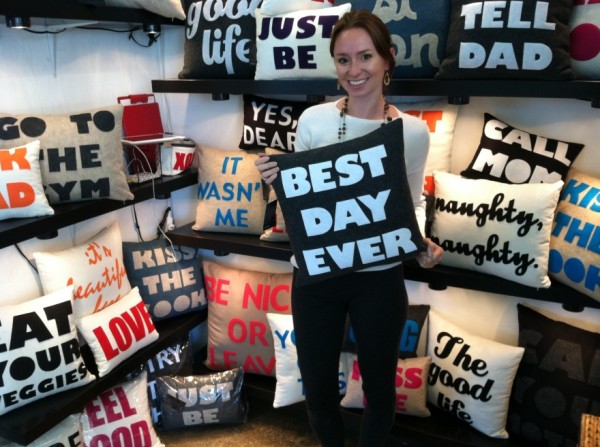
Alexandra Ferguson started small on etsy.com but now it’s her full-time career. She has more ideas in the pipeline and at least one already in production. (Photo: Brooklyn Artisan Photo Pool)
INSPIRED BY Bruce Campbell’s report, yesterday another Brooklyn Artisan team visited the design show at The Factory Floor (Industry City, 241 37th Street in Sunset Park, just across from Costco), and there encountered Alexandra Ferguson, about whom we’d written earlier. Hers would easily win a “Cheeriest Booth” award, with its colorful pillows enticingly arranged. You could almost hear the mental clicks of recognition as visitors to the show read them, nudged their companions, pointing out favorites to each other.
As Alexandra has recounted in her blog, she started her business in 2009 just about on a whim and a dime, posting on etsy.com a few pillows she’d made and expected to give friends as surprises. Business plan? Nada. Capitalization? Ditto. “Done is Better Than Perfect” was her slogan.
Sales were great, so she added more designs—sticking to environmentally friendly materials, of course—and her business grew and grew until it became her full-time livelihood. She moved it out of her apartment and into Mom’s garage in Westchester.
Alexandra Ferguson: The Business has taken another great leap upward, Alexandra (the person) says. Last summer she had four people working for her, but now to keep up with fall and holiday demand, she has added nine more employees. Her office and production space? Right here in Industry City. She moved it back to Brooklyn in July of this year. There are new product ideas, too. A makeup case, for instance.
Brooklyn Artisan had to ask: Where did she get her mantra? From Sheryl Sandberg, the author of Lean In, Alexandra said. And yes, we couldn’t resist; we told the story of originating the “Done is better than perfect” saying at Redbook magazine in 1979. You can read that backstory here.
Until we were starting Brooklyn Artisan, we had no idea the quote had gone viral. Cool.
Anne Mollegen Smith is editor and publisher of brookyn-artisan.net, and is a former editor-in-chief of Redbook, Working Woman, McCall’s, and the Art of Simple Living.
FURNITURE TAKES THE STAGE at The Factory Floor in Industry City in Sunset Park. The ground-floor venue is a former industrial space newly converted to showcase local design work. Sponsored by Industry City, the Brooklyn Chamber of Commerce, The Pratt Center for Community Development and the Brooklyn Navy Yard, The Factory Floor is presenting primarily Brooklyn furniture makers, designers and builders. Last weekend’s show coincided with the Sunday opening of the Coming Together: Surviving Sandy art exhibit in the adjacent building. If you are interested in the art and craft of design, this is the weekend to make it out to 241 37th Street, Sunset Park, Saturday and Sunday, 10am to 6pm. Bring the kids, Construction Kids has set aside an area where they can build their own objets d’art.
Here are a few highlights from Brooklyn Artisan’s visit:
Annie Evelyn at New Colony Furniture takes hard materials and makes soft seats. Really.
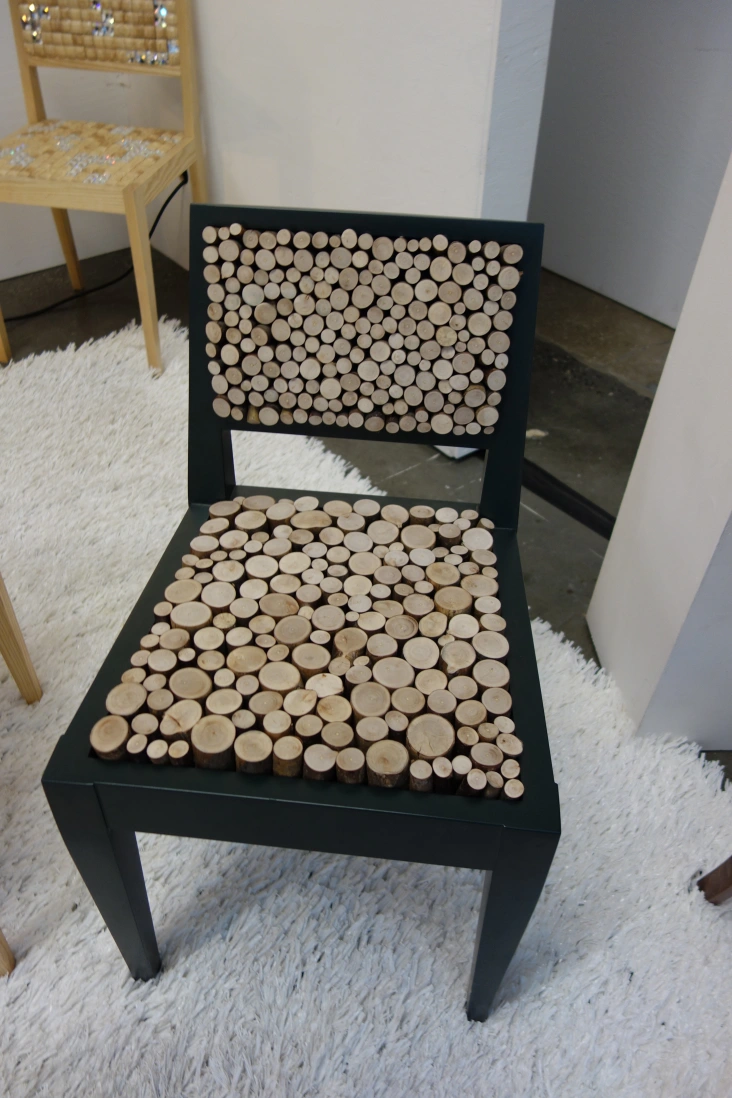
Diverse objects, from seats and shelves to vases and trivets at Souda’s space.

Funny and quirky pillow commentary from Alexandra Ferguson.

Beautiful maple stools and a passel of refrigerator magnets made from the leftover bits by Bower.
Apparently that WAS the wolf at the door, and someone let him in. Several blogs and the New York Observer have reported that following a brief frenzy of fundraising that most thought was just crying “wolf,” 3rd Ward has shut down abruptly. Members who have based their businesses there must scramble to get their inventory and gear and find new locations on the shortest of notice. Industry City, anyone?
UPDATE: In an email yesterday, 3rd Ward notified members that they must remove their stuff by day’s end October 11, and there will be no membership refunds. Gothamist reports: “Even 3rd Ward’s instructors were kept in the dark, many armed with lesson plans they’ll never use—and compensation they’re worried they’ll never see.” Nigel Shamash, an agent for the building itself, not 3rd Ward, is also scrambling to provide spaces for ousted 3rd Ward members.
Naturally there’s a website: SAVE3RDWARD.com. It is intended for the community, not for the 3rd Ward sponsors or administration, as businesses using the site figure out what to do. Some would like to retain studio space in the building, at least in the short term.
OF COURSE THE WEATHER TURNED FREAKISHLY WARM a few days after this sign was put out by Fleishers, the artisanal butcher on Fifth Avenue in Park Slope that specializes in grass fed, organic meats. But a timely menu suggestion has been made. Dust off the trusty stew pot or set out to acquire one, for chilly days will soon be here.
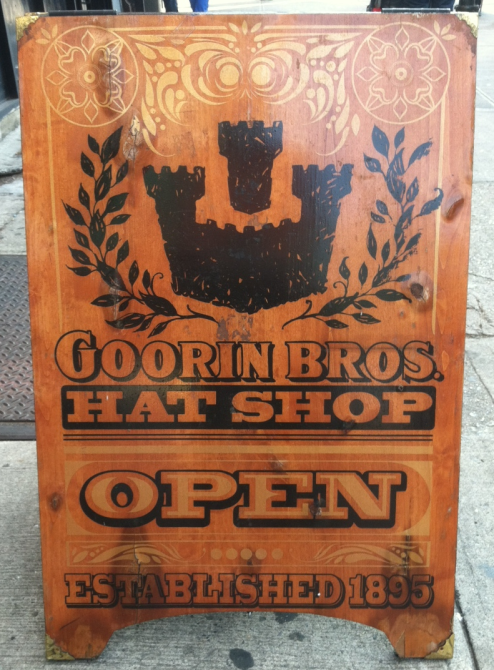
Founded in 1895 but not locally. There are more than two dozen stores in the US and two in Canada. (Large photo: Brooklyn Artisan Photo Pool)
WHAT COLOR WAS BOGEY’S FEDORA? 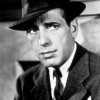 Tough question. Brown? Gray? I’ve always envisioned Humphrey Bogart wearing a brown fedora in any of his fedora-wearing good-guy movies like Casablanca. The movie was released in black-and-white, but in the scandalously colorized version from the ‘80s his suit is muddy brown, Ingrid Bergman’s silky dress is muddy yellow, and so is Bogey’s pocket square. The characters’ faces are muddy pink. Except Sam, the piano player. So that’s no help.
Tough question. Brown? Gray? I’ve always envisioned Humphrey Bogart wearing a brown fedora in any of his fedora-wearing good-guy movies like Casablanca. The movie was released in black-and-white, but in the scandalously colorized version from the ‘80s his suit is muddy brown, Ingrid Bergman’s silky dress is muddy yellow, and so is Bogey’s pocket square. The characters’ faces are muddy pink. Except Sam, the piano player. So that’s no help.
If anyone knows, it would be the Goorin Bros.
Goorin Bros. is pronounced like Gorn, that sluggish green lizard man that Captain Kirk battles to the death in Star Trek, the original series. The Brooklyn store at 195 Fifth Avenue isn’t like the team cap wall at your local Modell’s sporting goods, or the cheapo hat pile at the open-air bodega up the avenue, the place where you can buy an emergency stocking cap or a cheapo stingy-brim Justin Timberlake knockoff fedora resting in a pile on a folding table, all colors and patterns, in all sizes from small, medium, large, and X-large. This is a real hat shop, with expansive plate-glass windows with Goorin Bros. Est. 1895 in gold-leaf lettering, and shelves inside brimming (Get it? Brimming?) with hats. Though the store has just opened for the day, it’s already brimming (Again! Hah!) with customers. In front, helping a couple, assistant shopkeeper Nicky Culter, wears a Homestead Grays baseball cap sideways while showing a customer straw boaters, perfect for the summer season. In back, near the cash register, shopkeeper Alex Mroz finishes ringing up three others. He wears a Mahi Mahi, a light brown straw fedora that goes with his sharp suit.
”Why do you keep your hat on indoors?” I ask him straight off. It’s an insulting question, but my dad used to slap my head when I wore my baseball cap at the dinner table.
“This is a hat store. People expect it,” Mroz says. “Or I just tell people I’m religious.” After all, Goorin Bros. does carry black fedoras for the Hasidic set.
While baseball caps are always fashionable, felt hats began dying off in the late 60s as men grew their hair longer and stopped slathering it with Brylcreem. But lately real hats have begun a resurgence. You see bowlers, fedoras, even the occasional boater on the streets of Brooklyn or in the subways or buses. Like everything, you want to point to television; personally, I attribute it to Mad Men. And Justin Timberlake.
“There are a lot of cultural emotions going on. Not only Mad Men, but Boardwalk Empire and Downton Abbey,” Mroz says. “It’s partly the neighborhood,” he adds. People here have so much style.”
I tell him that I’m looking for a brown Bogey fedora, vintage Casablanca or The Big Sleep. He says they don’t have any in brown, but offers a gray fedora, the type Bogey wears when he plays the villain, like The Roaring Twenties. I try one on, but I need a double-breasted suit and a gat (that’s 30’s gangster-speak for a revolver) to pull it off.
Mroz thinks I might be interested in something with a narrower brim, a “stingy brim” measuring between an inch and an inch and three-quarters. After all, they have a wide selection. Again, I think Timberlake.
“You can just imagine Sinatra wearing one, hanging at the Sands with Dino and Sammy,” he says. “Sinatra is one of our hat heroes.” And no doubt: There’s a picture of Sinatra, with a feather stuck in his hat band. Which reminds Mroz: “We have a Feather Bar, where you can customize you hat to make a unique statement,” he says.
You get this guy talking about hats and there’s no stopping him. “This is a genuine panama hat, woven in Ecuador,” he turns to the display on a middle table and searches for my size and fits it on my head. Nah. I’m not the cigar smoking type.
I discover a stack on the shelf. “Now this looks like one Buster Keaton wore in his movies,” I say.
“It’s called The Buster. Keaton used to make his own hats.” Talk about small-batch artisanal. Except for the band, The Buster is barely discernable from the one Harold Lloyd wore while hanging off a clock in Safety Last.
“It’s a classic men’s summer hat—men wore them with the bands in their school colors,” he explains. And there’s a framed photo of a crowd of young men, apparently well dressed college men, though all you can really see is the tops of their straw boaters.
Goorin’s is not just about men’s hats: There are women’s in all shapes and sizes, the types that gals would wear in the Easter Parade on the Avenue, Fifth Avenue, when a photographer would snap them and they’d find themselves in the rotogravure. There are cloches and pillboxes, though nothing outrageously weird that Princesses Eugenie and Beatrice wore to Wills and Kate’s wedding.
Still, it’s a store where guys are happy to shop. There are top hats like Lincoln wore, though his measured a foot and a half high. Here they’re around half that height. And plenty of flat caps, which started as aristocracy wear, when the landed gentry would ride off with their shotguns and dogs chasing some poor fox. It usually ended badly for the fox. Within a few years they were co-opted by the city’s lower classes, like cabbies and newsies. Maybe flat caps should be renamed “The foxes revenge.”
Mroz shows me one last hat, a dark, wide-brimmed porkpie. “In Breaking Bad, Walter White wears one to be intimidating when he’s trying to collect money,” he says. I put it on and just look goofy. “You have to wear it with gusto,” he says.
No matter whether I have gusto or not, the prices are pretty reasonable. The lowest is $21, and handmades start at $79.
Handmade? That’s why I ordered a handcrafted brown fedora, just like Bogey wore in Casablanca. It’ll probably go great with my blue jeans, running shoes, and my Steely Dan t-shirt.
Executive Editor Phil Scott is the author of seven books and numerous magazine articles on travel, aviation, science, humor and brain health. He is teaching a journalism class at John Jay High School in Brooklyn.
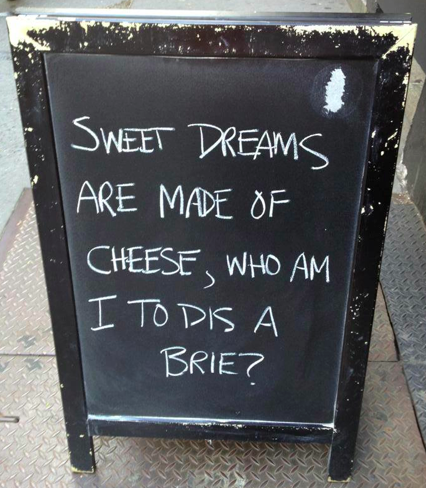 TRAVEL THE WORLD AND THE SEVEN SEAS, EVERYBODY’S LOOKING FOR SOMETHING: Today it might be a cheese or a chalk sign that makes you laugh in spite of yourself! After this, the Eurythmics’ song may never sound the same. (Photo thanks to Don Stitt)
TRAVEL THE WORLD AND THE SEVEN SEAS, EVERYBODY’S LOOKING FOR SOMETHING: Today it might be a cheese or a chalk sign that makes you laugh in spite of yourself! After this, the Eurythmics’ song may never sound the same. (Photo thanks to Don Stitt)
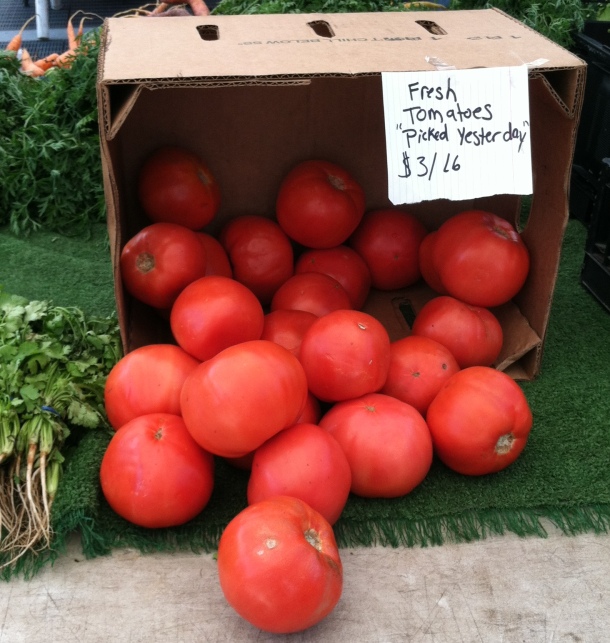

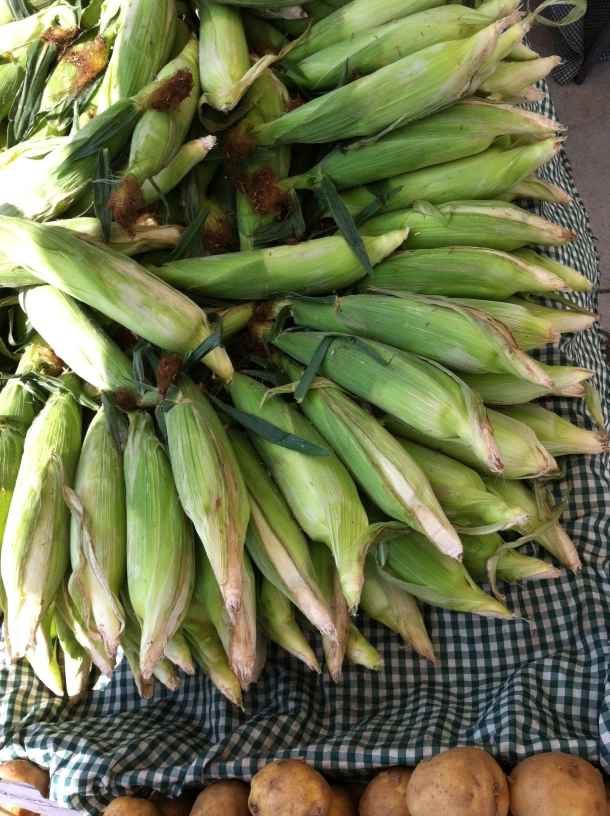
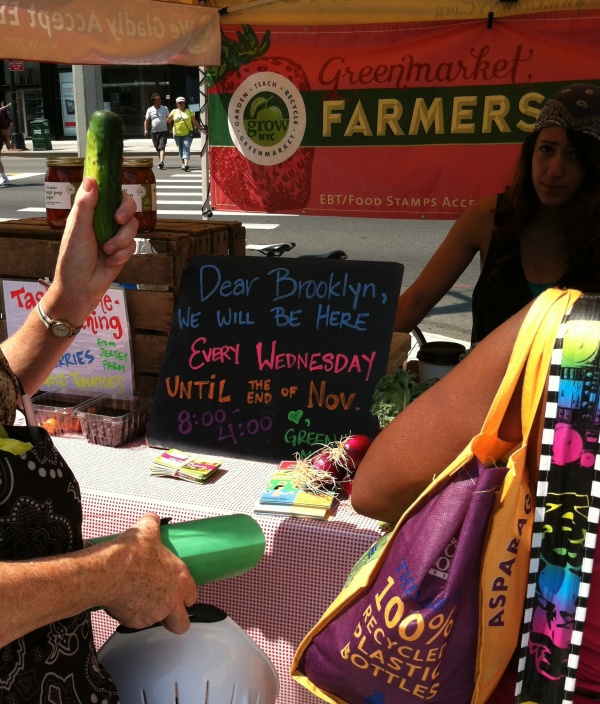
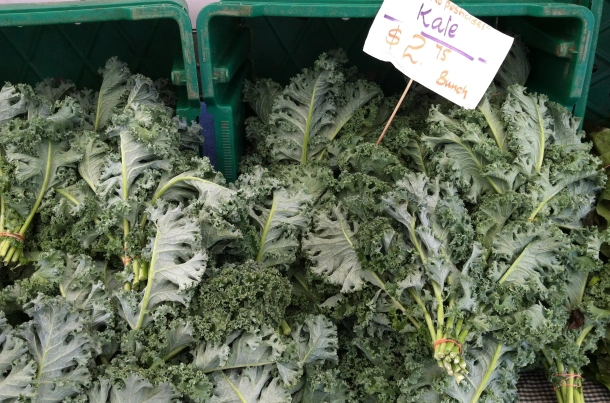 TODAY WAS LAUNCH DAY FOR THE NEW BARCLAYS CENTER GREENMARKET, in cooperation with GrowNYC. The market’s regular hours are 8 am to 4 pm on Wednesdays now through November. (Food stamps are accepted, even incentivized, at GrowNYC partner-markets.) Brooklyn Artisan braved today’s extreme heat to browse the farmstands and talk with the vendors, but didn’t stick it out for the mid-morning food demonstration of corn salads.
TODAY WAS LAUNCH DAY FOR THE NEW BARCLAYS CENTER GREENMARKET, in cooperation with GrowNYC. The market’s regular hours are 8 am to 4 pm on Wednesdays now through November. (Food stamps are accepted, even incentivized, at GrowNYC partner-markets.) Brooklyn Artisan braved today’s extreme heat to browse the farmstands and talk with the vendors, but didn’t stick it out for the mid-morning food demonstration of corn salads.
The new greenmarket is at the crossroads of Atlantic and Flatbush (look for the huge inflated rat), just outside Atlantic Terminal, so commuters-special shopping is definitely an option. Because of the heat, most stands closed early today, around 3 or 3:30, but they had opened bright and early, definitely ready to serve customers by 8. The familiar truck farm offerings included a few surprises such as nicely cleaned fish presented in well-iced cases (Hint: A sprinkling of salt on the ice makes it hold up better in the heat, the folks from Suffolk County’s American Seafood told us. If you’re planning to pick up some of their fish next week, though, best bring a cool pack and insulated bag to get it home.)
John D. Madura Farms had the biggest spread, from corn to carrots to kale plus potatoes (see photos above), radishes, and plenty more, grown at Pine Island in the Black Dirt Region of Orange County, NY. Staffing the booth was John D.’s young son Skuyler, who spoke with pride of the community-supported agriculture part of the family business.
The Body & Soul Vegan Bakery booth offered yummy-looking fancy breads and gluten-free items, many made with locally grown ingredients. James, behind the counter, was more than ready to explain the options and thought special orders could be arranged for pick up by particular customers. Body & Soul is long-established at the Union Square Market Mondays, Wednesdays and Fridays, where a dozen reviewers on a food site gave top marks to this year-round regular. (BTW, job shopping today too? Check on the bakery’s Brooklyn-based food prep and production jobs at indeed.com.)
Matt in the Applestate Hilltop Family Farm booth knows his bees, or at least their honeys, the way a vintner knows grapes. He was ready to share his expertise — the sweetest honey came from the clover-fed bees, he said, whereas the wild-flower nourished bees produced a more nuanced flavor. The pure-honey complexities are interesting. (As he talked, Brooklyn Artisan imagined friends-and-family brunches built around honey-tastings.) The Applestate Hilltop aviary is in Calicoon, Sullivan County, NY.
Of course, it wouldn’t be Brooklyn artisanal without pickles! Rick’s Picks of Dutchess County has been producing hand-packed and all natural pickles “since 2004” and today was pushing Rick’s Picks’ Hotties – referring not to the smiling gentlemen in the booth, but to their crenelated cucumber and julienned veggies bottled with special hot (“but not searingly so,” one New York Times writer judged) pickling spices. Rick’s Picks pickles come in sweet flavors (4 choices), savory (6 choices), spicy (3 — hotties, mean beans, and smokras) and several special proprietary blends. Gift packs can be ordered from Rick’s Pics and you can even get low-sodium pickles from them.
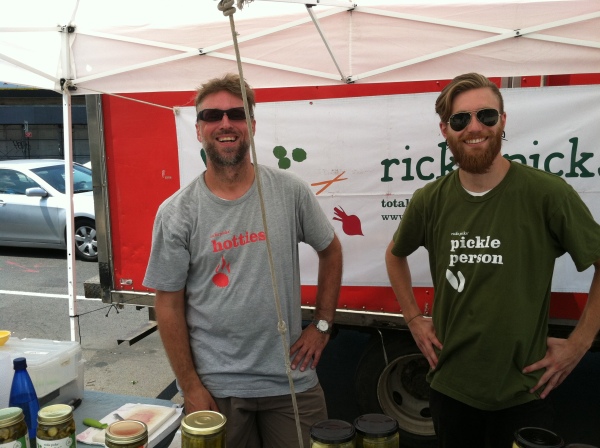
Rick’s Picks’ artisanal pickle vendors sport shirts that don’t permit taking themselves too seriously.
GrowNYC’s handy credit-card sized fold-out of greenmarkets and farm produce outlets that take EBT credit lists nearly 50 in the Heartland (Brooklyn), and another 100 in Outer Brooklyn locations. Photographs: Brooklyn Artisan Photo Pool.
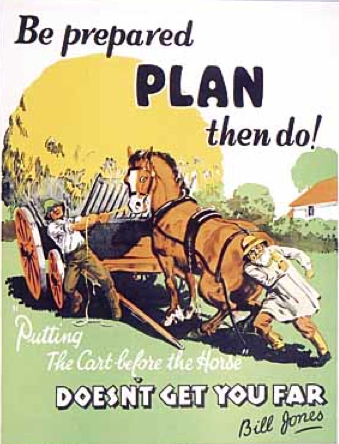
Here’s the conventional wisdom, but does it still apply? (Business and career coach Bill Jones first appeared on motivational posters in the 1920s and 30s.)
WHY DONE IS BETTER THAN PERFECT, says the Etsy Blog title for the June 20, 2013 entry by Alexandra Ferguson. And then the art shows a cute cushion with the message, Ready, Fire, Aim. As the originator of “‘Done’ is better than ‘perfect'” (explained in an addendum to an earlier post to this blog), I like to think that in today’s conditions these mottos make more sense than they did in Bill Jones’s day.
Ms. Ferguson observes that many businesses get stuck in “paralysis by analysis” rather than going forward. Her own story is a case example that encourages leaping from the daydream stage into production and selling – in her case, selling her handmade cushions on etsy.com. Her first offering of message pillows she’d already made cost $1.60 in listing fees, a very low capital requirement to enter a business! No lease. No significant inventory. No staff. No equipment beyond what she’d needed for gift-cushion making as a hobby. Her launch served as a market test — and a commitment test. Was this really a business she could stay in? DUMBO-based etsy.com made it not only cheap and easy to get her product to market, but the market itself is global.
Smorgasburg and the Brooklyn Flea help other artisan-entrepreneurs test themselves in the food business by providing venues and some basic disciplines. The Brooklyn Botanic’s celebration of hot chiles is another. Ample Hills Creamery founder Brian Smith took his unusual ice cream flavors to market via ice cream trucks and kiosks before committing to that first lease in Prospect Heights. Brooklyn’s growing network of co-working spaces and commercial kitchens keep equipment and production space costs thinkably low. Share-and-learn facilities like 3rd Ward in Williamsburg can graduate their biggest successes to Industry City in Sunset Park.
Brooklyn Artisan Executive Editor Basia Hellwig reports in “Start Ups Aren’t for Sissies” on some entrepreneurial thrills and chills. Her stories provide mental preparation. BA Executive Editor Joy Makon’s look inside Alchemy Creamery gives another window into what’s involved. BA Executive Editor Phil Scott and Contributor Bruce A. Campbell have reported on Brooklyn’s Makerbot, pioneer of 3D printers. There’s venture capital out there to back some winners.
Tomorrow, Brooklyn’s first food and drink trade show, Brooklyn Eats, presents a new opportunity. It is sponsored by the Brooklyn Chamber of Commerce and a host of corporations like commercial Citibank, Fairway, Whole Foods, National Grid, Verizon, and Acumen Capital Partners LLC and Jamestown Properties, as well as the Daily News and Edible Brooklyn as media partners.
The bright line between artisan and entrepreneur shines when the Alexandra Fergusons and the Brian Smiths of the world realize they’re not just creating cute cushions or unique premium ice cream flavors, they’re creating businesses. Should they move beyond bootstrapping? How much bigger can small-batch get before small-batch loses its edge? Sounds like it’s time for a serious, stage-two business plan. That’s when a trade show like Brooklyn Eats or a presentation to a venture capital fund really starts to make sense. It’s only been a very few years since Makerbot stepped up, after all, and it’s now valued at $403 million. Who’s next?
Brooklyn Artisan Editor & Publisher Anne Mollegen Smith was editor-in-chief of Working Woman magazine when its circulation grew to 950,000.
BUSINESS OWNERS SHANE WELCH, FOUNDER OF SIXPOINT BREWERY in Red Hook, Matthew Tilden, founder of SCRATCHbread in Bed-Stuy and Charlie Sahadi, proprietor of Sahadi Importing Co. in Brooklyn Heights, showed their business scars and shared some hard-earned wisdom at a recent Brooklyn Public Library conversation, “Fantastic Food,” led by photographer Randy Duchaine, whose “Created in Brooklyn” exhibition of portraits inspired the series:
If the adjoining property comes up for sale, buy it.—Charlie Sahadi
Sahadi remembered this advice from his father when two buildings on Atlantic Avenue came up for sale in 1977 for what seemed, at the time, an impossibly astronomical price. “Owning your property is a very big plus. Landlords want to become your partner without doing the work. We scrimped and bought the buildings. Now when I look back at the price, of course, I feel as if we stole the property.”

“You have to innovate—adapt and change with the times,” says Charlie Sahadi (above).
“Sahadi’s is an ingredients store, but then we opened a deli to show off what you can
make with all these ingredients.” Photograph by RandyDuchaine.com
When a cohort of producers grows up in a neighborhood, that’s good. —Shane Welch
“We all root for each other. If there’s only one place in a neighborhood, it might be hard to get people to come to you. But now in Red Hook you have roving bands of food tourists who make a day of it and stop at three or four places.” (Similarly, Sahadi talked about Trader Joe’s opening up near his store, which far from being a competitive threat, is introducing a whole new set of customers to Sahadi’s, he says, and helping make “downtown Brooklyn a foodie paradise.”)
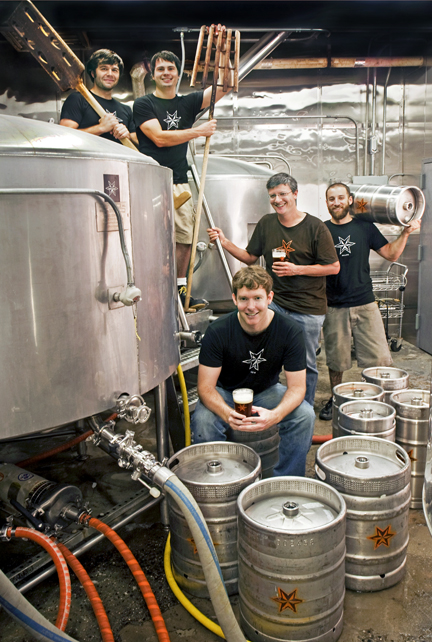
“We knew Brooklyn would grasp what we were doing with beer,” says Shane Welch, front, with his Sixpoint Brewery crew. “And the mineral profile of the water here is virtually perfect for brewing.” Photograph by RandyDuchaine.com
Don’t take yourself too seriously, but do serious work.—Matt Tilden
“Be humble. Work hard, focus on community betterment and sharing knowledge. A brand is a living breathing thing; for us, it’s a statement about food.”
Make the transition from hustler to operator—a perspective Tilden remembers Welch sharing with him over dinner one night.
Welch explains: “Everyone starts out hard-scrabble, hustling. But as you and the business grow and mature, you legitimize. Operators figure out how to get things done the right way. It can be poisonous if you remain a hustler. Say you do building without permits and then someone gets hurt. That could be the end of your business.”
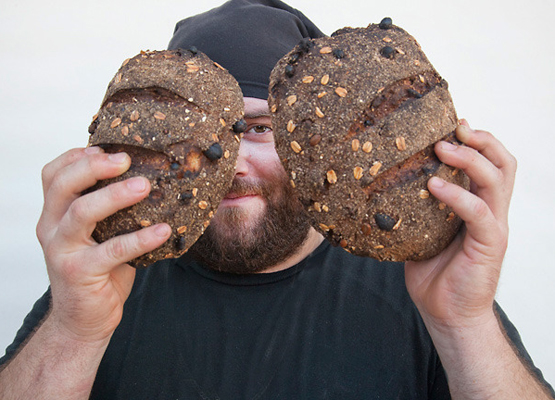
Matt Tilden, founder of SCRATCHbread: “Brooklyn is approachable sophistication.
It’s a family culture with an edge. I relate to raw and rustic.” Photograph by RandyDuchaine.com
Give people a good product, at a fair price, with good customer service.—Charlie Sahadi
When Sahadi says, “Our customers become our friends,” you believe him if you’ve ever stepped inside his store. “Shopping with us has to be a pleasurable experience. We’re part of our customers’ lives. Otherwise, we’d just be another store on Atlantic Avenue.”
This is one they all could agree on. Regulations are one of the biggest threats to New York City small businesses, they said. You have to be on top of them, and there are hundreds of them—city, state, federal—and they seem to change almost hourly. Dept. of Agriculture, NYC Dept. of Health, Landmarks Preservation, Dept. of Buildings, the list goes on.
Yes, of course these owners value their customers’ safety and health. But can’t it be easier? A 2008 update to the NYC building code complicated everyone’s lives enormously, they report. Sahadi’s first planned a store renovation in 1999; they got all the approvals, but then decided to postpone construction when they bought a big warehouse in Sunset Park. By the time they were ready to build, the 2008 revision was in effect. “It drove us a little crazy to get all the right permitting,” says Sahadi, “especially since our buildings also come under the Landmark Preservation Commission.” He credits his son, Ron, and his daughter Christine with managing the project and getting it done.
A sole proprietor can find it overwhelming to manage the contracting, building and running back and forth to city offices for permitting while keeping the business going—not to mention staying on top of the regulatory changes. Shane Welch finds himself dealing with the Dept. of Homeland Security now, since the Tax and Trade Bureau, which governs the excise tax on beer, was swallowed up in it. Day-to-day, it’s a little like being nibbled to death by ducks. For instance, SCRATCHbread got a ticket recently because its benches were three feet further out than they were supposed to be—one of hundreds of details a business must keep track of. “Now don’t you think the inspector could simply have pointed it out?” Matt Tilden wondered. “I’d have been happy to move them.”
The “Created in Brooklyn” exhibit is on display at Brooklyn Public Library until August 31. The conversations continue in June and July, on Wednesdays from 6:30 to 8 pm: June 26, Design Crafts; July 10, Urban Adventures; July 17, Art & Music.
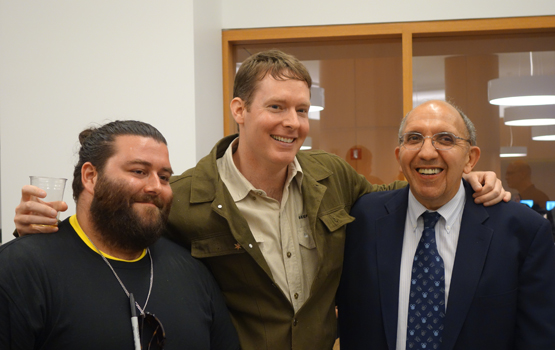
Sharing their business stories: from left, Matthew Tilden of SCRATCHbread, Shane Welch
of Sixpoint Brewery and Charlie Sahadi of specialty food retailer Sahadi’s.
ANY BUDDING ARTISANS IN THE AUDIENCE at a recent Brooklyn Public Library panel, “Fantastic Food,” would come away both sobered and heartened. Three business owners—Shane Welch, founder of Sixpoint Brewery, Matthew Tilden, founder of SCRATCHbread and Charlie Sahadi, proprietor of Sahadi Importing Co.—all shared disaster stories and cautionary tales but there they were, smiling happily about the businesses they ran, unanimous that they’d go through it all again in an instant.
The June 19th event was the first in a series of conversations the library has organized around an exhibition of portraits by photographer Randy Duchaine called “Created in Brooklyn,” which will be on display until August 31.
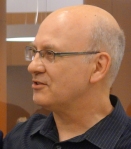
Photographer Randy Duchaine, whose portraits inspired the conversation series.
Duchaine, who led the conversation, has evocatively captured dozens of Brooklyn makers and creators who “come here to live their dreams, express themselves, start a business and contribute to society through their talents,” as he puts it. “They represent…a sense of independence and the ability to stand on their own two feet and proudly say, ‘This is what it means to be an American in Brooklyn!’”
The lively interchange was followed—lucky us—by samples of the businesses’ artisanal breads, beers and Mediterranean appetizers. Here are some of the start-up war stories they shared:
Shane Welch, Sixpoint Brewery “It’s hard to secure a commercial lease with no assets, no credit, no money. So we had to hard-scrabble it.” In 2004, he and a partner found an 800-square-foot garage to rent in Red Hook, not exactly ideal for a brewery and full of old equipment. “It was a junkyard really.” They cleaned it out and bought a couple of used tanks for a few hundred dollars at auction—one had been a dairy tank and another was rusted out. That one came with its own craft brew karma. It turned out it had been used originally by the Sierra Nevada Brewing Co. in California and had probably literally worked its way to the East coast, being handed from hopeful brewer to brewer. “I have a background in chemistry so we made a solution that no living organism could survive. We emptied them, scrubbed them out, sanitized them, bleached them.”
Bright Side: Sixpoint just closed on the purchase of property next door and is establishing power cred in the red hot world of craft beer. It is on the brink of a big expansion, planning to build a new brewing facility to suit this time.
Charlie Sahadi, Sahadi Importing “I was 23 when my father died suddenly. I’d been working in the business, but my father’s approach was, ‘Let me worry about the business, you take care of the customers.’ So when he died, I had no idea how to do certain things. ‘Where do we get the feta?’ I asked his partner. ‘I don’t know.’ ‘How about the olives?’ My father had been the dominant partner so all the details went with him.” Luckily, Sahadi was able to get in touch with a bookkeeper his father had used in the past, to come in and temp. She knew exactly where they bought the feta and a lot more besides, and her “temp” job has lasted 25 years.
Bright Side: Sahadi Importing has become an institution on Atlantic Avenue and is celebrating its 65th year in business. “You wake up and every day’s a challenge, but that’s what I love.” The store went through a recent renovation and expansion, overseen by his daughter Christine and son, Ron. Charlie Sahadi has justly earned the title of the Ambassador of Atlantic Avenue.
Matt Tilden, SCRATCHbread: “I was working as a chef 115 hours a week and wanted out. I kept thinking, I really don’t want to work somewhere where a pan gets thrown across the room because someone made a mistake. I answered an ad: ‘We have wood oven, you make bread’ and began moonlighting as a baker. I traded bread for rent; for a while I lived out of my car. Four years later, I wanted my own place. We raised a little money from selling at markets and Kickstarter. With no capital there are so many adjustments you have to make. You can’t always do things the way you would with proper funding. I got a friend to deposit money temporarily in my account so I could get approval for a lease. I staffed with interns, lots of interns.”
Bright Side: Everyone’s on payroll now. After doing a wholesale business with restaurateurs like the Union Square Hospitality Group of Danny Meyers, SCRATCHbread has refocused on its retail presence in Bed-Stuy. “We are all about being a conscious owner. Eating healthy is hard, I know that. When you put something in your body, it’s fuel. We like giving people good nourishment, caring for people. We play good music, focus on hospitality, something I’ve always admired about Danny Meyer.”
More, later, on some of the business tips they shared—and one thing they all agreed on. Plus a few of Randy Duchaine’s photographs.
Mark your calendar for the next conversations in Brooklyn Public Library’s “Created in Brooklyn” conversation series led by photographer Randy Duchaine. Held Wednesdays from 6:30 to 8 pm in June and July: Design Crafts, June 26, Urban Adventures, July 10 and Art & Music, July 17.
Photographs by Basia Hellwig
Correction: An earlier version gave an incorrect date for the Design Crafts “Created in Brooklyn” event. It takes place on June 26.
MAKERBOT, DEVELOPER OF A POPULAR 3-D PRINTER, today announced that it is merging with Stratasys in a deal worth $403 million. The Brooklyn-born and -based MakerBot recently moved into a 50,000 square foot space in Sunset Park. Not bad for a four-year-old startup.
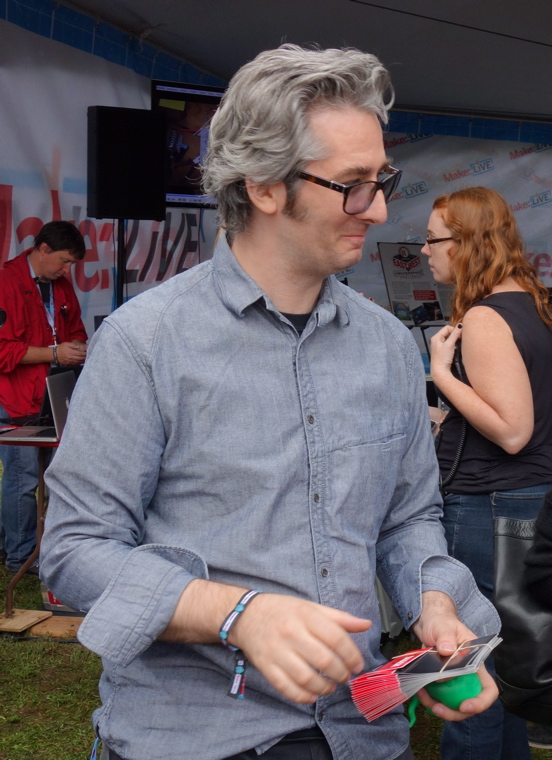
Bre Pettis, CEO of MakerBot, at last summer’s Maker Faire in Queens.
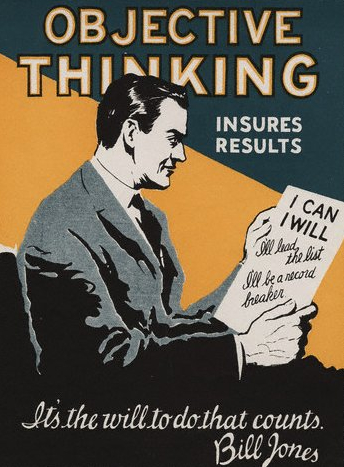
One might quibble about how “objective” the pep talk is, but the Bill Jones motivational posters have clear messages.
OFF MY MIND AND ONTO MY DESKTOP: One can relish the relief of listing tasks to be done tomorrow in order to stop worrying about them tonight. Whether it’s on a piece of paper, in a file on the computer, or on a whiteboard in the corner, it’s good to leave the list at work when the day’s over. If it’s in an app on a mobile, best not to check it until tomorrow.
Off my desk and onto yours: Delegating has at least two forms. One is giving away the task and putting it completely out of mind, knowing the results will be apparent without further effort on your part. The other is assigning the task and expecting to follow up to be sure it gets done, to praise or nudge or redirect. In the second case, the task hasn’t really been given away, it’s just been transformed from one kind of task to another.
Off my list and out of my mind: It’s worth remembering that one form of prioritizing is not letting a task get onto one’s personal to-do list in the first place. If the list has gotten too long anyway, then decide which things not to do. Let go of them, at least for now. That keeps the list from being overwhelming.
 REMOVE THE DOUBT — THAT’S ANOTHER WAY OF SAYING HEADS MUST ROLL when certain types of screw-ups occur. So after the IRS’s targeting of Tea Party groups to search out 501 (c) 4 violations made such big news, the acting head of the agency had his “resignation asked for and accepted.” Could he have survived in the job if he’d broken the findings to the President himself simultaneously with firing the hands-on people involved? Maybe.
REMOVE THE DOUBT — THAT’S ANOTHER WAY OF SAYING HEADS MUST ROLL when certain types of screw-ups occur. So after the IRS’s targeting of Tea Party groups to search out 501 (c) 4 violations made such big news, the acting head of the agency had his “resignation asked for and accepted.” Could he have survived in the job if he’d broken the findings to the President himself simultaneously with firing the hands-on people involved? Maybe.
And maybe even if he couldn’t get out in front of the news, but had acted quickly to remove those most responsible. That’s what Hillary Clinton and her management cadre at the State Department did after the tragic news from Benghazi broke; when she “accepted responsibility” for inadequate security at the Benghazi post, it was clear she was speaking in code — it happened in her agency and she was handling it: The faulty decision-makers were already on the way out the door .
We’re still waiting to see what the fallout will be after what looks like excessive phone monitoring of the AP in an effort to find the recent big leaker.
Even more, we’re still waiting for Wall Street and banking to “accept responsibility” and clean up after the financial crisis, the “liar’s loan” mortgage mess and the wrongly foreclosed housing.
In a small-business context, when a client’s order has been screwed up, it’s up to you to ‘fess up, clean up, sometimes even pay up, and show what action you’re taking to be sure it never happens again. A change of employees, a new procedure, or taking over that dawn delivery route yourself — whatever will “remove the doubt.” That’s a business fundamental.
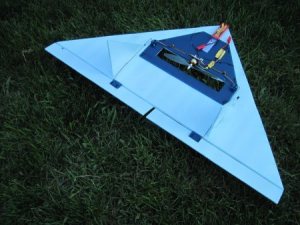
Forget Area 51, this is North Brooklyn’s mystery aircraft, built from Brooklyn Aerodrome’s Kit 145 ($250.).
BROOKLYN HARDLY SEEMS THE PLACE TO TAKE FLYING LESSONS, given the utter and complete dearth of airports in the borough. But that hasn’t stopped computer scientist Breck Baldwin and schoolteacher Andrew Woodbridge from starting the Brooklyn Aerodrome Flight School. It offers training, clocks hours of flight time and then issues pilot licenses – to middle-schoolers.
The program began in 2010 with 15 students. Most of the curriculum is online, and the textbook can be bought online for $30. In complete and utter contrast with No Child Left Behind, the law of the land in which students study for nothing but the exam, the new Brooklyn Aerodrome Flight School actually teaches real-world applications for science and technology in a context that interests these students: making and flying planes. Brooklyn Aerodrome showed at last fall’s World Maker Faire in Queens and got a lot of attention, including from Wired Magazine. But a failed Kickstarter campaign in the first quarter of this year was a setback. Despite that they’re still up and running; for more info go to brooklynaerodrome.com.
Okay, there’s no functional Brooklyn airport, which goes to say no full-size airplanes either. So the kids go to the other most logical site, Brooklyn’s own McCarren Park in Williamsburg, and fly their own easy-to-build model called Flack, for Flying Hack. “It’s an electric-powered remote-control airplane built out of recycled trash,” Baldwin says. “Kids can build one in three to four hours.”
“It’s about aeronautics, that’s the core of it,” says Baldwin. “But the whole thing is trying to get kids to think about math, science and engineering and make it fun and play—not sit in a room and be lectured, but to go outside and do it.” In other words it’s not rote book learning, but real-world, hands-on knowledge and experience.
“Solving workbook math problems is not how the world works, but students might have to do a lot of math to get something to work,” Baldwin adds, the “something” being their airplanes. The program is not ignoring the liberal arts either: the students write reports, too, technical ones, not a “My Favorite Superhero Is…” essay.
And what do the kids get out of it? Not only math and science (and lots of fun), but they learn how general aviation really works, along with its rules and regulations. That last part may not be glamorous but it is essential, Baldwin says: “It makes it more real, adds depth to it, but it also provides structure. You have to have permission to enter the ‘runway,’ then you have to get permission to take off, and then the next plane goes.
“There’s a lot of necessary structure to flying,” Baldwin says, before he pauses and adds, “Imagine 30 kids with powered airplanes.”
Executive Editor Phil Scott has clocked some air time himself, not only in airplanes but also a replica of a Wright Brothers glider at Kitty Hawk, N.C.,.
As has widely been reported, less than two weeks ago Lt. Col. Jeffrey Krusinski, head of the Air Force’s Sexual Assault Prevention and Response program, was arrested and charged for allegedly sexually assaulting a woman in a suburban parking lot in Virginia.
The fictional Bill Jones was the voice of career advice in the 1920s and 30s posters put out by a British printing company. Though the advice here was meant in another context, it’s not hard to imagine what Bill Jones would have thought about sexual assault or harassment, or derailing one’s career in this way.
Can you imagine it? http://superb.joeyvrsecky.comAnne Mollegen Smith
http://fair.alexandernichols.ca
Anne Mollegen Smith
http://second.indiancollegeofhealthcareexecutives.com
Anne Mollegen Smith
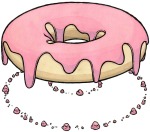
IN THE SINGULAR ECOSYSTEM that is Kickstarter, one will encounter many evolutionary dead ends—projects, visions and dreams that wither away unfunded. Then there are the mysterious campaigns that don’t just meet their targets, they blow by them and reach double, triple or stratospherically higher funding results. Why and how do these hyperachievers succeed, and can we learn any […]
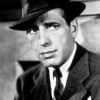
By Phil Scott
WHAT COLOR WAS BOGEY’S FEDORA? Tough question. Brown? Gray? I’ve always envisioned Humphrey Bogart wearing a brown fedora in any of his fedora-wearing good-guy movies like Casablanca. The movie was released in black-and-white, but in the scandalously colorized version from the ‘80s his suit is muddy brown, Ingrid Bergman’s silky dress is muddy yellow, and […]
“Ready, Aim, Fire” or “Done is Better Than Perfect”? WHY DONE IS BETTER THAN PERFECT, says the Etsy Blog title for the June 20, 2013 entry by Alexandra Ferguson. And then the art shows a cute cushion with the message, Ready, Fire, Aim. As the originator of “‘Done’ is better than ‘perfect’” (explained in an addendum […]

BUSINESS OWNERS SHANE WELCH, FOUNDER OF SIXPOINT BREWERY in Red Hook, Matthew Tilden, founder of SCRATCHbread in Bed-Stuy and Charlie Sahadi, proprietor of Sahadi Importing Co. in Brooklyn Heights, showed their business scars and shared some hard-earned wisdom at a recent Brooklyn Public Library conversation, “Fantastic Food,” led by photographer Randy Duchaine, whose “Created in […]

Created in Brooklyn: Food and Drink Entrepreneurs Talk Shop ANY BUDDING ARTISANS IN THE AUDIENCE at a recent Brooklyn Public Library panel, “Fantastic Food,” would come away both sobered and heartened. Three business owners—Shane Welch, founder of Sixpoint Brewery, Matthew Tilden, founder of SCRATCHbread and Charlie Sahadi, proprietor of Sahadi Importing Co.—all shared disaster stories and […]
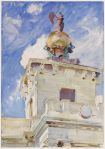
OUR BROOKLYN MUSEUM’S SHOW OF NEARLY 100 WATERCOLORS BY JOHN SINGER SARGENT, created jointly with Boston’s Museum of Fine Arts — pooling art from both collections and wisdom from both museums’ curators and conservators — is every bit as good as you’ve probably read and heard by now. Good coverage is on the museum site and […]

SOME YEARS I JUST CAN’T BE THE VALENTINE GIVER I’D LIKE TO BE. Flu, deadlines, house guests, or no excuses, it just happens. So this year, on the way home from the Q train, I’m skidding into Natural Land on Flatbush Avenue to pick up some chocolate I’ve been eyeing from time to time. The flavors sound […]

By Phil Scott
BROOKLYNITE TODD JONES CALLS HIMSELF A “DONUTOLOGIST.” You know, just as archaeologist Heinrich Schliemann studied archaeology, namely the archaeology of ancient Troy, donutologist Jones studies donuts, namely sweet, sticky, delicious mini donuts, each a deep-fried doughy circle. Not Dunkin’ Donut donuts, or Starbucks donuts, but hot, fresh mini donuts. “Glaze will come out of my […]
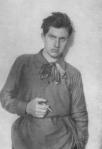
ON THURSDAY NIGHT AT THE COMMUNITY BOOKSTORE ON SEVENTH AVENUE, Heather O’Donnell set out to shine a little light on the subject of rare and collectible books for more than a dozen of her Park Slope neighbors. “Rare books are my passion,” she said, and hastened to reassure her listeners sitting with books on their […]
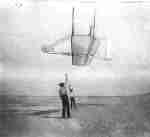
By Phil Scott
Yesterday was Kitty Hawk Day, which provoked this reminiscence. THE WRIGHT BROTHERS NEVER TRUDGED UP THIS DUNE BAREFOOT. That’s what I’m thinking last spring as I try to negotiate the wings of a 1902 Wright glider up a sandy winding trail carved out of Jockey’s Ridge with Kitty Hawk Kites’ clean-cut manager Bruce Weber and assistant recreation manager […]
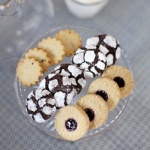
Day Eleven • 12 Tastes of Brooklyn I WAS INVITED TO MY FIRST COOKIE-EXCHANGE holiday party this year, but alas, now it’s been cancelled and all motivation to cover myself in flour and sugar has gone out the window. Luckily, Brooklyn is rich in cookies—beautiful ones made by hand with the finest ingredients by the most […]

Day Nine • 12 Sips of Brooklyn TAXONOMY, CLADISTICS, SYSTEMATICS, PHYLOGENETICS—so many ways to group and divide living things. Darwin famously sundered the world into “lumpers and splitters”: those who are happy with the general gist, and those who are obsessed with specifics. The tea trade is one where splitters can run riot: green or […]
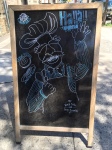
August 8, 2016
For Swedish espresso aficionados, or the merely curious, Konditori in Prospect Heights is on Washington Avenue between St. Marks and Prospect, where it projects a friendly attitude. “Keep calm and stay Swedish” is the message of the day. Cardomom Brod is a featured menu item. Or you could choose the hairy calorie bomb, aka the […]

October 2, 2013
OF COURSE THE WEATHER TURNED FREAKISHLY WARM a few days after this sign was put out by Fleishers, the artisanal butcher on Fifth Avenue in Park Slope that specializes in grass fed, organic meats. But a timely menu suggestion has been made. Dust off the trusty stew pot or set out to acquire one, for […]

12 Views, 12 Tastes and 12 Sips of Brooklyn
By Anne Mollegen Smith [
IF GROWING THIS BLOG were modeled on “Jack and the Beanstalk,” we are at the point of the story where I have traded the family cow for three little beans. I have confidence in the growth potential of those three little beans, but the current stage feels a bit awkward. Rather than hold out for polished […]
By Anne Mollegen Smith [
I KNOW WHAT A STRUGGLE it can be to name your business. When we named the parent company of Brooklyn Artisan, our first project – producing A Computer Dictionary for Kids and Other Beginners for Ballantine Books – was already well underway. Many clever, engaging, adorable, double-takeable, quotable and otherwise wonderful company names occurred to us. But when […]
By Anne Mollegen Smith [
BROOKLYN INDUSTRIES, Brooklyn Bagels, Brooklyn this, Brooklyn that, it’s everywhere–so big a brand that it subdivides. (Smorgasburg, The Gowanus Yacht Club, Prospect Park West.) New York Magazine calls Brooklyn’s artisanal foods movement “The Twee Party.” The New York Times writes more respectfully about Brooklyn’s “unique food culture.” Blogs spring up with names using almost every conceivable spelling […]
By Guest Blogger [
by John J. Kochevar I WROTE MY DISSERTATION with a wooden pencil. Or, rather, many wooden pencils. We rented a summer cottage in Effort, Pennsylvania where, every morning, I carefully sharpened every pencil in my collection before sitting down to write. I think I read somewhere it was Ernest Hemingway’s custom each morning to sharpen all […]
You must be logged in to post a comment.